Krabi Thailand, South West Monsoons, Day Trading PC Build

Quick Click Links
Feature Photograph Krabi Thailand, South West Monsoon Day Trading PC Build Photography News of Interest
Readers Submissions Readers Questions A Snapshot of Bangkok Images Week in Review Infocus Blog, the Psychology of "Reconditioned."
T
Feature Photograph *menu

Canon 5d Mark II, 24-70mm F2.8L USM @F8 1/60th 64mm ISO 400
Some years back I found myself sitting on a bench at the Maesa Elephant Camp watching this thoughtful Pachyderm paint a picture.
No, with the exception of one, you won’t be seeing any more of my images of elephants, elephant sanctuaries, tigers, tiger temples, or the dozens of other such places housing protected species in Thailand. Why? I can’t tell you exactly when, but it was over 5-6 years ago when I had this epiphany. No matter what label they stuck on it, no matter what they were saying during interviews on national television, the primary reason these people became involved with protected species is because they could make a buck. They can make more bucks by claiming they’re doing great things for these species. I could and should write a book about this topic, after all I have more than enough photos and supporting documentation and research. But ultimately it would be seen in a negative light by the powers to be, and I’d still like to enjoy access to Thailand.
Back to the painting elephant. Do you think he was consciously creating art? I do, and I sat there observing for a long time. This made me think about how he got there, and indeed there is a long path of training by their mahouts. The elephant started
as a species you wouldn’t expect to create art, and evolved to creating some passable images. Sounds a lot like me.

Canon 5d Mark II, 24-70mm F2.8L USM @F8 1/60th 32mm ISO 400
Where do we start? Somewhere the seed is planted. My seed was planted while hanging out of a Huey sideways with a Nikon F and a long lens taking pictures of the troop buildup along the fence line of Guantanamo Bay during the Grenada action. Like every
other person who calls him/herself a photographer, the seed was planted and it grew.
This seed will continue to grow as long as it’s nurtured. All too often a hobbyist gets busy with other parts of their life and this seed “sleeps” for lack of a better word, but it never dies. It’s always there
waiting for you to nurture it once more with a little water, a new lens, a fun trip with the family, or maybe a walk through a local gallery.
It’s a bit different for a professional. The elephant in the room is far too many professional photographers feel they’ve reached Nirvana. But for those of us who are more grounded we often need to kick ourselves in pants from time to time
to get that seed nurtured and grow on to that next level.

Canon 5d Mark II, 24-70mm F2.8L USM @F8 1/100th 51mm ISO 400
Personally I tend to concentrate my growth in whatever direction my current client lead me. This sounds too obvious right? I suppose it is, if I’m getting a lot of requests for portraits I’ll do the portraits, critique my own work, and then
look for ways to improve. This is my nature. There’s always room for improvement and room to grow to the next level. Lots of room.
Over the last 4-5 years I’ve been writing this column and maintaining my website I feel like I’ve grown. I look at the images I produced then, and images I produce now, and I see a world of difference. Some of it is technical from improved
gear, but the vast majority of it is my skill levels. Skill with the gear, skills during post processing, and skill in seeing. I’m most concerned and proud of my progress with seeing.
The second and third images in these articles are images I could have taken long ago. They’re nice images of fall scenes. Nicely framed, ideally exposed, and post-processed in tune with my personal taste. The first image might not be as good or
as appealing to many of you, but the first image represents my growth.
What do you see when you look up through the trees in fall? Most get sun in their eyes and look away, but if you shade your eyes and really look you’ll notice the leaves are translucent, more or less at different stages of their growth. You’ll
notice that in nature there are very few if any straight lines. Each leaf has its own individual shape, colors are more uniform but they’ll vary from area to area. Looking through the trees I saw a naturally occurring painting. Nature’s
art.
It felt a bit weird, like processing someone else’s image. Yet, for hours I sat there and hand painted each individual leaf, changing its color and luminosity just enough to make it stand out from the leaves next to it. Natural patterns were emphasized and I tried not to miss the smallest detail. If you had this file in its full size you could zoom in and not see any sign of changes. This image is nothing like the original, yet it’s exactly like the original. It allows me to represent, to you, what I was seeing when I looked up through those trees. The next level. I hope you like it.
Krabi Thailand, South West Monsoon *menu
BigJoe is a name you’re going to hear more of. BigJoe is career Army currently serving his twilight tour in Korea and we’ve been corresponding regularly for some time concerning photography. He displays a strong natural eye for composition and lately he’s been turning out some really nice work and it just keeps getting better. I enjoy his narratives as well and I think you will too. You can send Feedback to BigJoe here. Bigjoe.jh64@gmail.com
The Southwest Monsoon Brings Krabi Color to Light
While planning my vacation to the Kingdom last winter I decided I wanted to take things at a slower pace and relax. My requirements for this was a nice beach with photographic potential, relaxing nightlife options, daytime activities and a variety of dining options. My vacation dates were at the end of may into the beginning of June, right smack in the middle of the monsoon season.

Canon EOS Rebel T2i 550D, EF 16-35 F/2.8L USM @ f/10 1/100th 22mm (35.2mm equivalent) ISO 100
While planning my vacation to the Kingdom last winter I decided I wanted to take things at a slower pace and relax. My requirements for this was a nice beach with photographic potential, relaxing nightlife options, daytime activities and a variety of dining options. My vacation dates were at the end of may into the beginning of June, right smack in the middle of the monsoon season. Information on several “travel” sites had me worried that I would be spending much of my time indoors as the prevailing winds were to bring rain; rain and more rain. Going to Google Earth where I often research travel destinations I identified several possibilities and then narrowed my search down to Krabi, Koh Samui, Koh Chang and Phuket. Having been to all but Krabi, it was on the top of my list. More research revealed that the Krabi rains were daily but usually short in duration and avoidable. They also pointed out that due to the rain the foliage would be at its greenest. This was enough for me to give it a try and see Krabi though my own lens. After spending more time on Google Earth I decided Ao Nang best fit my needs as it appeared to be more developed than other areas. Nothing against living with nature but it’s my vacation and I like to vacate in comfort. How did I determine by looking at a map that there was adequate development? I looked for a Starbuck… and the only store in Krabi was in Ao Nang. Whether you like Starbucks or not the fact that a store is in an area tells me it is developed and has the infrastructure to support the colossal coffee chain. I can assume from this that enough people visit the area for other amenities and activities to be close at hand. This doesn’t mean I won’t go somewhere unless there’s a Starbucks on the corner. Not at all, I’ve enjoyed eighteen wonderful months in the southern Philippines and seven months in Afghanistan without a single grande skinny caramel macchiato.
With the destination for the final week of my trip decided, I finished planning the remaining itinerary, boarded a plane and headed to Bangkok. My first week in country was spent exploring along the west coast of the Gulf of Thailand. This trip to Jomtien, Pattaya and surrounding beach communities, where daily evening downpours were a constant reminder of the monsoon season, provided me a point of comparison for the upcoming Krabi adventure.
The beaches of Jomtien had the standard beach chairs and umbrellas found on most Thai beaches. It seemed the farther south you went the more litter you encountered. A few of the vendors had their areas cleared with the debris marking the edge of their territory.

Canon EOS Rebel T2i 550D, EF 16-35 F/2.8L USM @ f/11 1/125th 16mm (25.5mm equivalent) ISO 100
The beaches of Jomtien had the standard beach chairs and umbrellas found on most Thai beaches. It seemed the farther south you went the more litter you encountered. A few of the vendors had their areas cleared with the debris marking the edge of their territory.

Canon EOS Rebel T2i 550D, EF 70-200 F/2.8L IS @ f/5.0 1/1000th 70mm (122mm equivalent) ISO 100
While driving through Rayong past the oil refineries I came across a nice stretch of beach in Mae-Rampung that looked to be the home to a small community of EXPATs.

Canon EOS Rebel T2i 550D, EF 16-35 F/2.8L USM @ f/13 1/160th 16mm (25.5mm equivalent) ISO 100
The park at the west end was a nice addition to the beach for the local communities enjoyment.
There were some hard working characters out who were happy to have their picture taken. This guy offered up some lao kao which I respectfully declined, being the designated driver. He, of course, didn’t understand but bid me a grand farewell none the less.

Canon EOS Rebel T2i 550D, EF 70-200 F/2.8L IS @ f/2.8 1/2000th 200mm (320mm equivalent) ISO 100

Canon EOS Rebel T2i 550D, EF 70-200 F/2.8L IS @ f/2.8 1/160th 70mm (112mm equivalent) ISO 100
There were some hard working characters out who were happy to have their picture taken. This guy offered up some lao kao which I respectfully declined, being the designated driver. He, of course, didn’t understand but bid me a grand farewell none the less.

Canon EOS Rebel T2i 550D, EF 16-35 F/2.8L USM @ f/10 1/100th 18mm (28.8mm equivalent) ISO 100
Heading back to Jomtien a short detour took me by this makeshift boat yard in Ban Amphur. The colorful Thai boats definitely make an interesting subject.

Canon EOS Rebel T2i 550D, EF 16-35 F/2.8L USM @ f/8.0 1/60th 16mm (25.5mm equivalent) ISO 100
Ban Amphur was a very clean beach lined with chairs, umbrellas and food vendors. It was a nice place to stop for dinner and capture a few images.

Canon EOS Rebel T2i 550D, EF 70-200 F/2.8L IS @ f/5.6 1/160th 85mm (136mm equivalent) ISO 320
Many of the local children and adults were enjoying the quiet summer afternoon. I like how the three yellow umbrella stands near the girls mark the DOF. This was totally by accident, of course, as at the time I was experimenting with the camera settings and pretty much just pointing and shooting.
After visiting some old friends in Pattaya it was time to head to Krabi and get down to some serious relaxation. When I arrived the weather was nice and the blue skies were full of large white and grey clouds. The prospect of rainy days was still on the horizon, literally, and at this point and I was determined to make the best of it regardless of the weather. The hired car ride to the hotel was enjoyable and I got my first views of the limestone cliffs that loomed around every corner. I regret not capturing images of these and plan to go back for that reason alone. I arrived at the hotel and was immediately pleased with my choice of accommodations.

Canon EOS Rebel T2i 550D, EF 16-35 F/2.8L USM @ f2.8 1/30th 16mm (25.5mm equivalent) ISO 1600
At the low season prices the room hotel was well worth price. There was some upkeep and renovations going on, common during the low season, but it didn’t interfere with my plans.
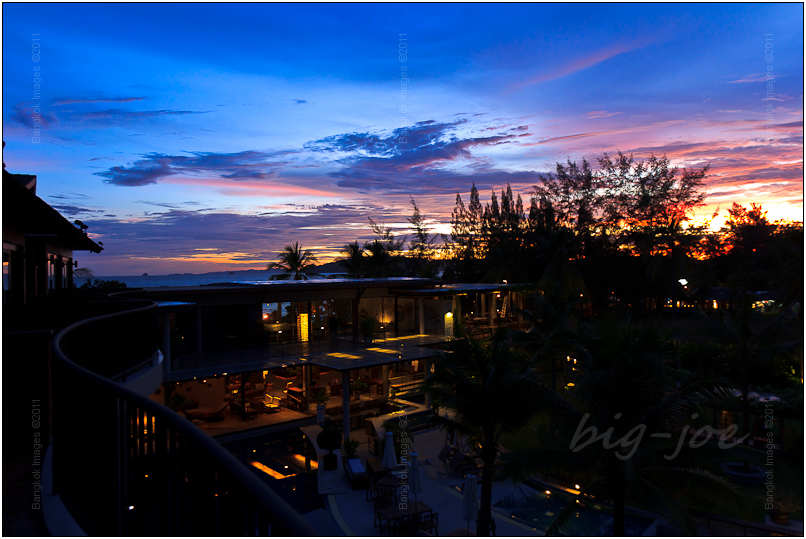
Canon EOS Rebel T2i 550D, EF 16-35 F/2.8L USM @ f/2.8 1/8th (tripod) 16mm (25.5mm equivalent) ISO 400
My room on the third/top floor was perfect and the wrap around balcony provided a great vantage for setting up the tripod and working on some long exposure shots.

Canon EOS Rebel T2i 550D, EF 16-35 F/2.8 USM @ f/2.8 1.0 sec (tripod) 16mm (25.5mm equivalent) ISO 800
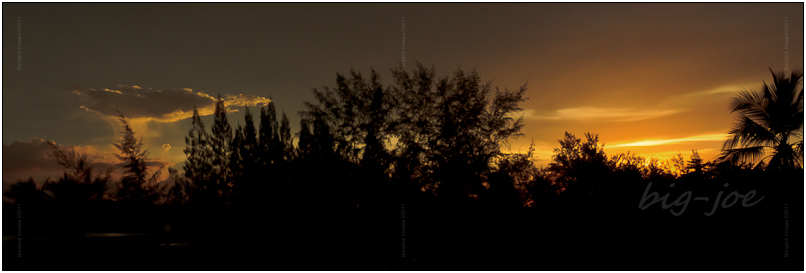
Canon EOS Rebel T2i 550D, EF 16-35 F/2.8L USM @ f/22 1/100th (tripod) 24mm (38.4mm equivalent) ISO 800
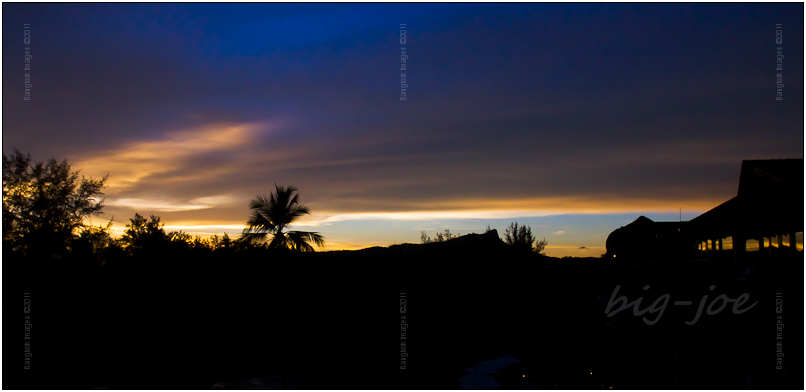
Canon EOS Rebel T2i 550D, EF 16-35 F/2.8L USM @ f/22 1/100th (tripod) 24mm (38.4mm equivalent) ISO 800
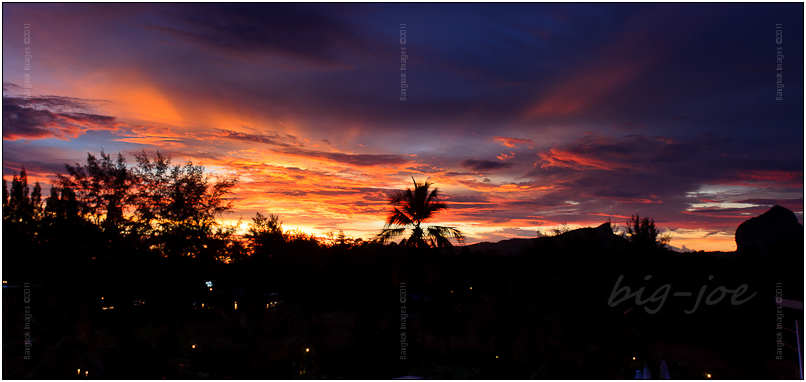
Canon EOS Rebel T2i 550D, EF 16-35 F/2.8L USM @ f/22 1.0 sec (tripod) 16mm (25.5mm equivalent) ISO 100
Capturing sunsets from the vantage of the balcony was convenient and fun.
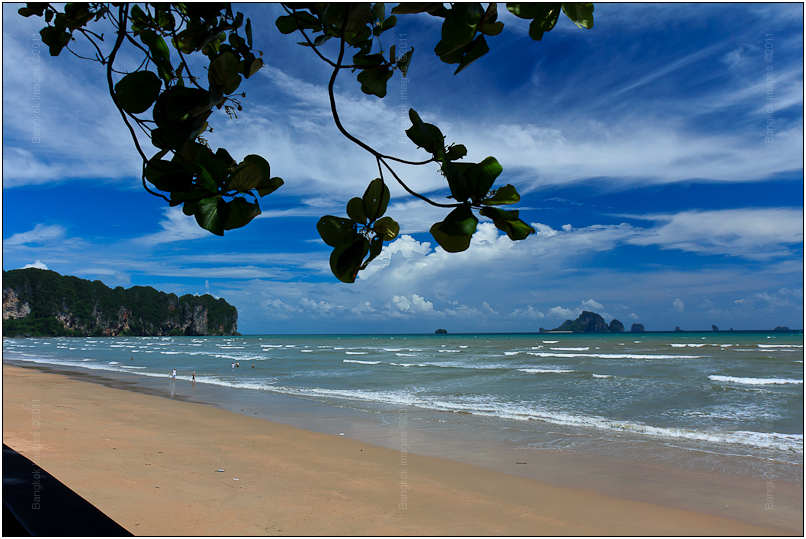
Canon EOS Rebel T2i 550D, EF 16-35 F/2.8L USM @ f/10 1/125th 16mm (25.5mm equivalent) ISO 100
I spent the next seven days exploring taking pictures and basically having a good time. Almost everywhere you go you can find a photo opportunity. This image was taken from the table of a seafood restaurant at the west end of Ao Nang beach.
When it rained it rained hard but for the most part it was passing showers. One day the hotel staff warned me of expected rain for the entire next day so I opted to drive and ferry across to Koh Lanta out of the path of the wet weather. Koh Lanta Yai and Noi (big and small) are the two southern most islands in Krabi. The southernmost, Lanta Yai, showed great potential but it seems there is something holding the development of this area back. I found opportunities for taking shots few and far between. The locals, not seeming to want outsiders around, along with a few run down or abandoned resorts and an underdeveloped infrastructure gave it an unwelcome feeling. The northernmost point of Lanta Yai was the exception where there is a luxury resort but little to do outside of the resort area. This not to say that someone else would not enjoy these islands. I just didn’t find them that interesting. My apologies for not having no images to back up these statements. It seems my photojournalism days may be numbered.
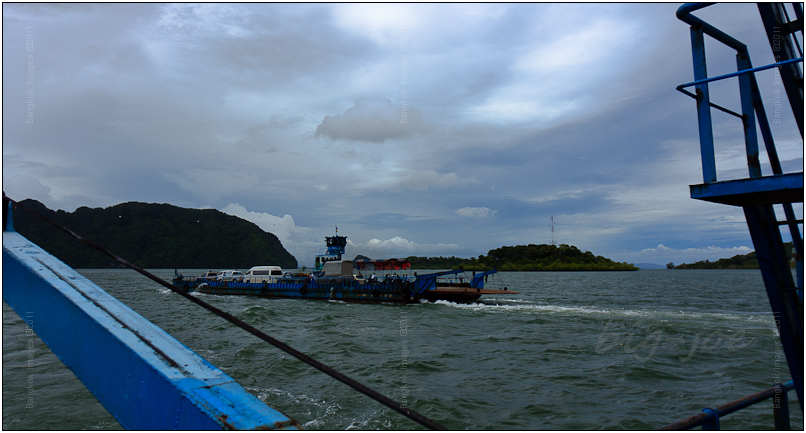
Canon EOS Rebel T2i 550D, EF 16-35 F/2.8L USM @ f/2.8 1/250th 16mm (25.5mm equivalent) ISO 100
Ferry to Koh Lanta.
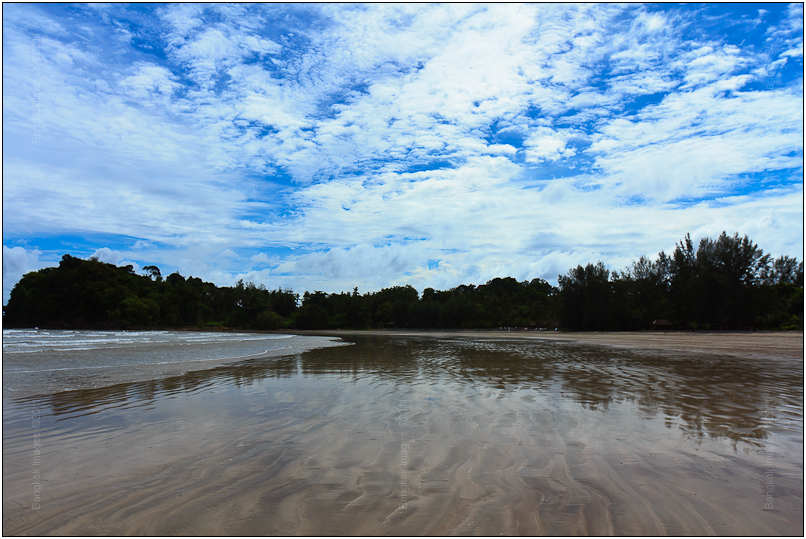
Canon EOS Rebel T2i 550D, EF 16-35 F/2.8L USM @ f/2.8 1/1600th 17mm (27.2mm equivalent) ISO 100
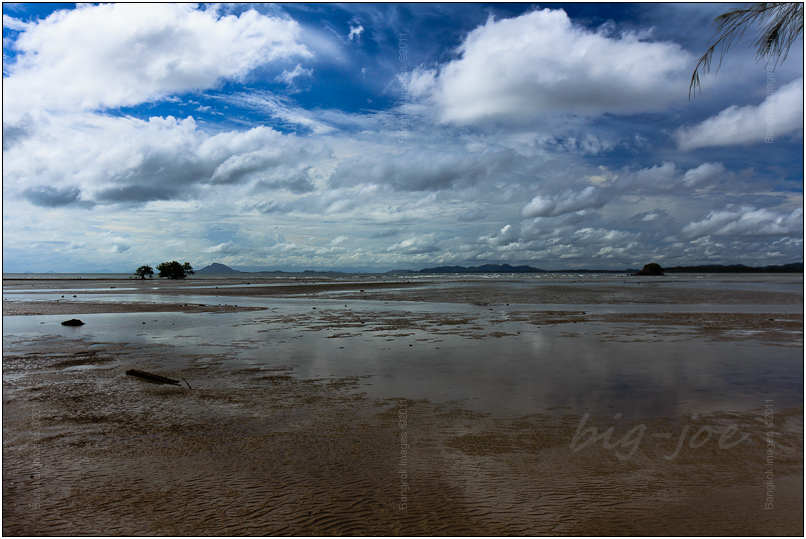
Canon EOS Rebel T2i 550D, EF 16-35 F/2.8L USM @ f/2.8 1/1600th 16mm (25.5mm equivalent) ISO 100
These images were taken at the northwest point of Lanta Yai near the luxury resort. The beaches are immense flat stretches of fine sand and silt. The waves along this shore were among the largest I have seen in Thailand.
That evening when I returned to Ao Nang the rains had not lasted the whole day and the evening light was nice for shots on the beach in front of the hotel. Here I started practicing long exposures on a tripod in order to give the ocean waves a smooth mist like appearance
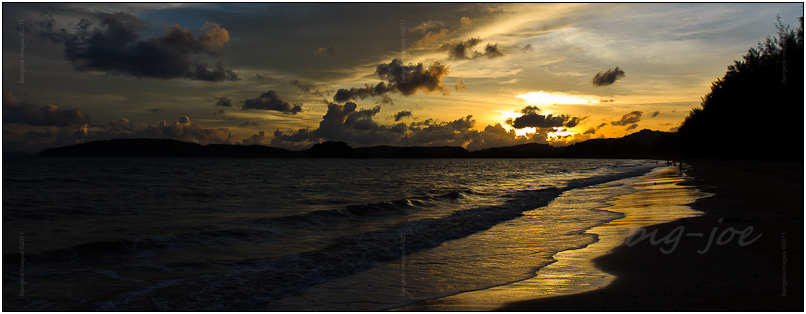
Canon EOS Rebel T2i 550D, EF 16-35 F/2.8L USM @ f/10 1/100th (tripod) 16mm (25.5mm equivalent) ISO 100
A short exposure taken at sunset from a tripod cropped down during editing.
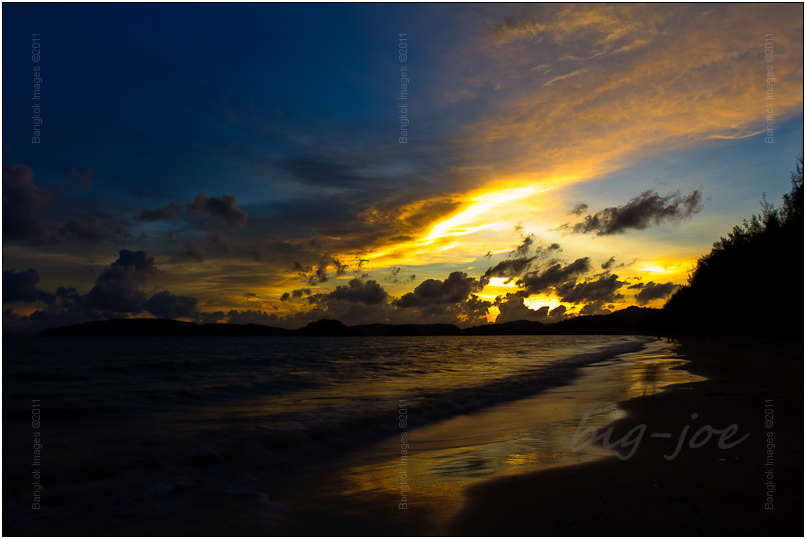
Canon EOS Rebel T2i 550D, EF 16-35 F/2.8L USM @ f/22 0.4 sec (tripod) 16mm (25.5mm equivalent) ISO 100
Taken from the same location on the tripod with a slightly longer exposure.
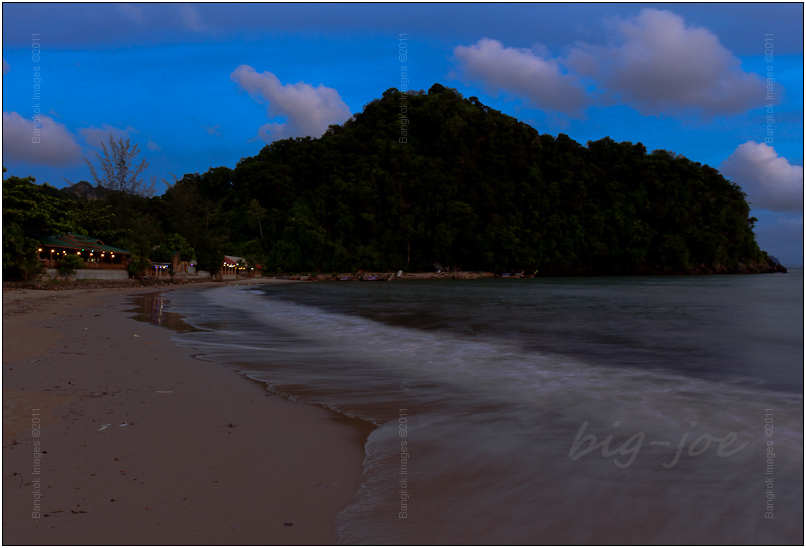
Canon EOS Rebel T2i 550D, EF 16-35 F/2.8L USM @ f/22 1.6 sec (tripod) 16mm (25.5mm equivalent) ISO 100
The beach became a bit too crowded to my front so I turned the camera to the east and was surprised to see the hilltop lit up by the setting sun. The waves in this even longer exposure are take on that look of being in motion.
I roamed the beaches daily and found them to be clear of the umbrella and chair rentals, jet skis and multitude of vendors found on other beaches. I’m not sure if this was due to it being low season but I did hear that there is an ordinance not allowing beach chair renters. The east end of Ao Nang beach had vendors and massage ladies under the shade of trees off the beach.
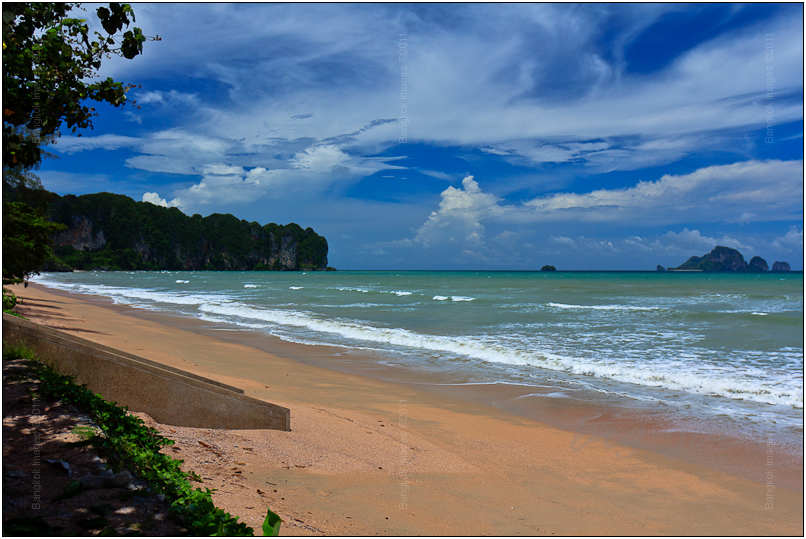
Canon EOS Rebel T2i 550D, EF 16-35 F/2.8L USM @ f/2.8 1/600th 18mm (28.8mm equivalent) ISO 100
The beaches were mostly deserted with few tourist around. Not only was there very few beach goers but there was also very little trash. Perhaps there’s a correlation between the two.
At the east end of Ao Nang beach you can find a trail of wooden planks leading over a hill to a secluded beach with its own resort . The trail offers some interesting vantages of that beach and Ao Nang Beach.
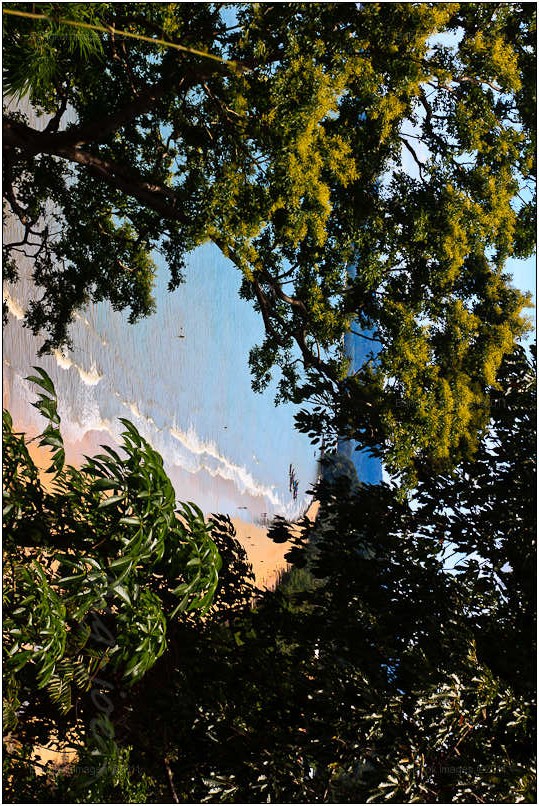
Canon EOS Rebel T2i 550D, EF 16-35 F/2.8L USM @ f/7.1 1/100th 35mm (56mm equivalent) ISO 100
Peering through the trees at Ao Nang beach.
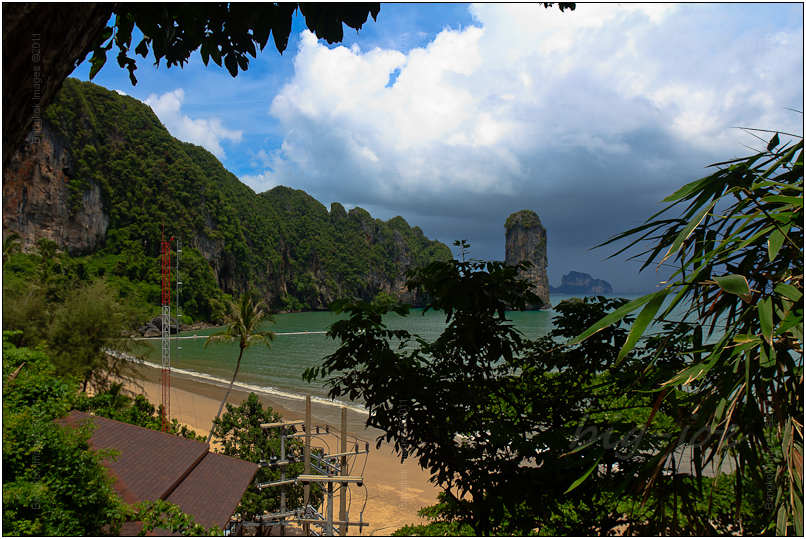
Canon EOS Rebel T2i 550D, EF 16-35 F/2.8L USM @ f/8.0 1/60th 16mm (25.5mm equivalent) ISO 100
An attempt at getting a shot of the secluded beach from the trail. I believe the name of the beach is Pai Plong Bay or beach.
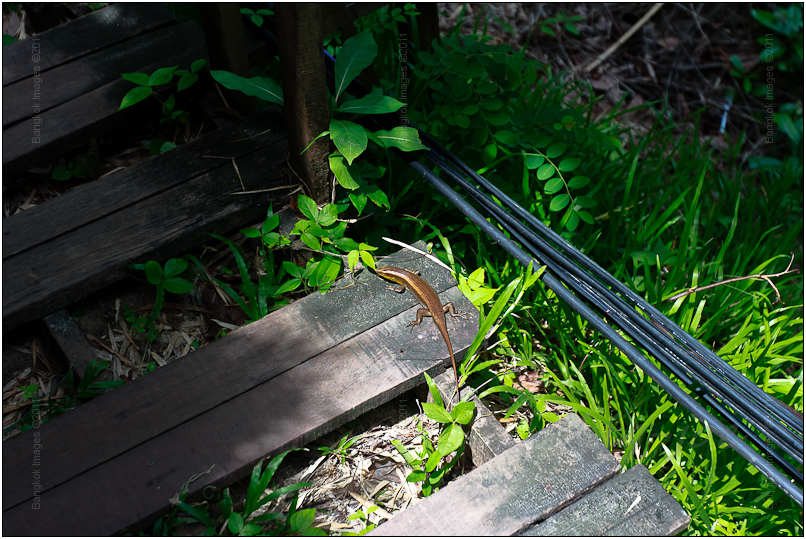
Canon EOS Rebel T2i 550D, EF 16-35 F/2.8L USM @ f/2.8 1/125th 35mm (56mm equivalent) ISO 100
Bring water and be careful as the trail is steep and in need of repair. There are also signs warning of monkeys on or near the trail and be careful not to step on this little guy.
Once over the trail you find yourself on a private beach with security that will ask you to sign their guest register before you enter. The beach here is well maintained and seems to belong to the resort.
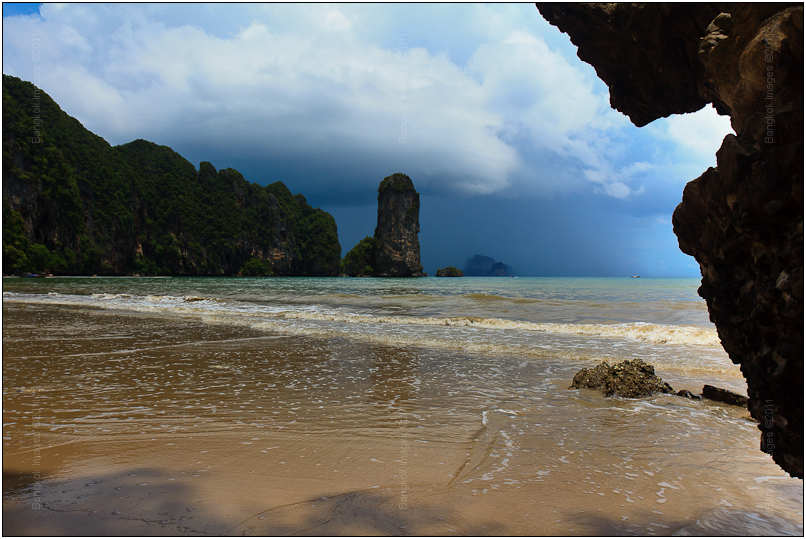
Canon EOS Rebel T2i 550D, EF 16-35 F/2.8L USM @ f/10 1/100th 16mm (25.5mm equivalent) ISO 100
This shot was taken from the west end of the beach under an overhanging rock face.
As recommended by Steve, instead of showing the same image every tourist to Krabi has as their screen saver, turn the camera in the other direction and get the other side of the story. This wasn’t my plan at the time as my focus was primarily on the rock formations on the water. I did have a few shots of the cliffs over the resort.
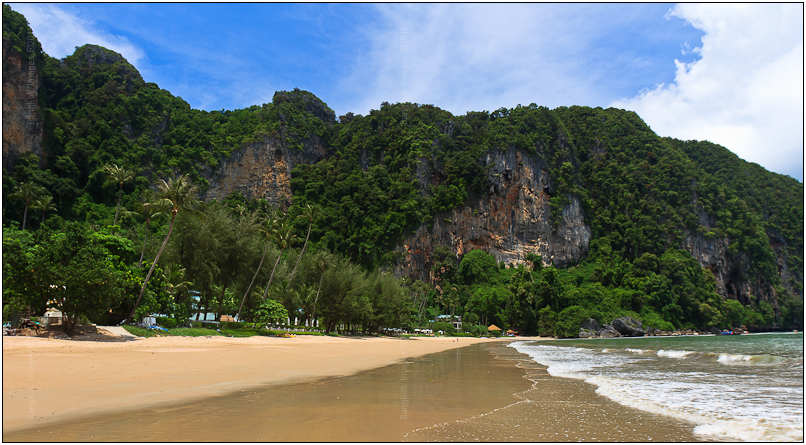
Canon EOS Rebel T2i 550D, EF 16-35 F/2.8L USM @ f/8.0 1/60th 16mm (25.6mm equivalent) ISO 100
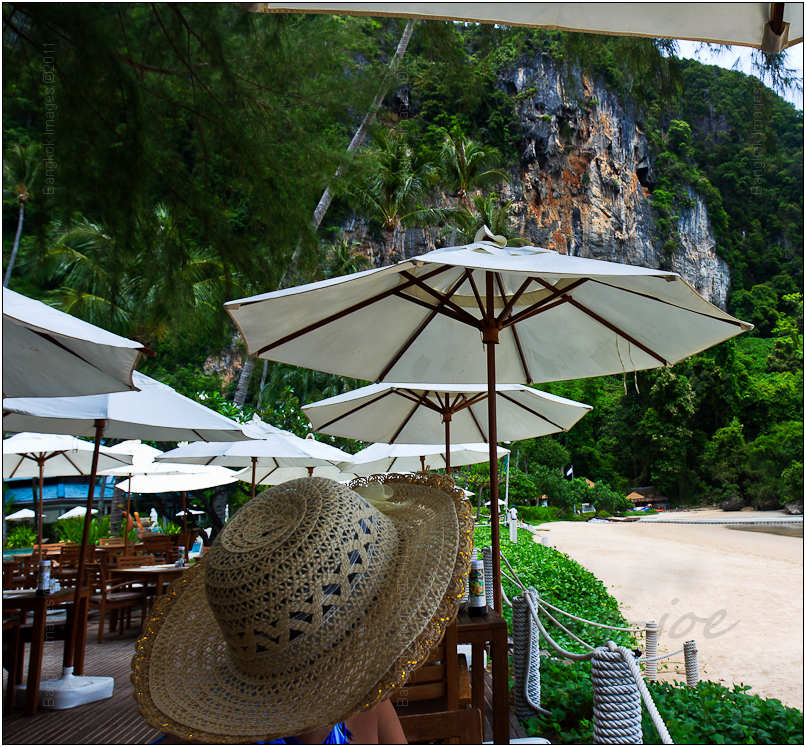
Canon EOS Rebel T2i 550D, EF 16-35 F/2.8L USM @ f/7.1 1/50th 16mm (25.6mm equivalent) ISO 100
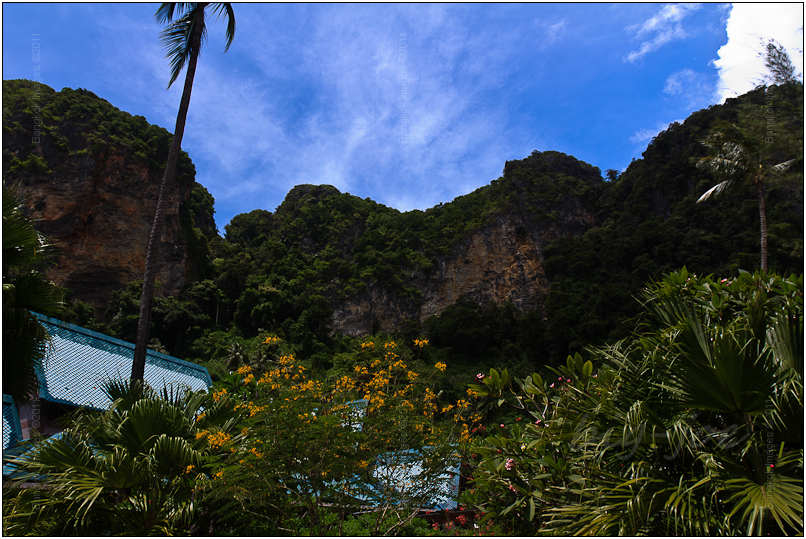
Canon EOS Rebel T2i 550D, EF 16-35 F/2.8L USM @ f/8.0 1/60th 16mm (25.6mm equivalent) ISO 100
Next time I will look to find a better composition. Maybe a shot from a boat in the bay.
Boats can be hired from Ao Nang and other local beaches to the many small beaches that are not accessible by car. It’s advisable to catch one from the public beaches and arrange a round trip as there were none for hire on Pai Plong beach.
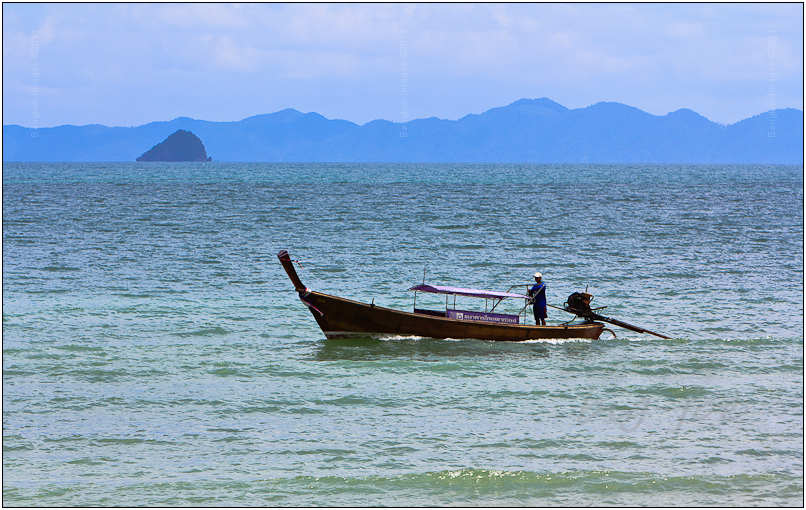
Canon EOS Rebel T2i 550D, EF 70-200 F/2.8L IS USM @ f/8.0 1/500th 200mm (320mm equivalent) ISO 100
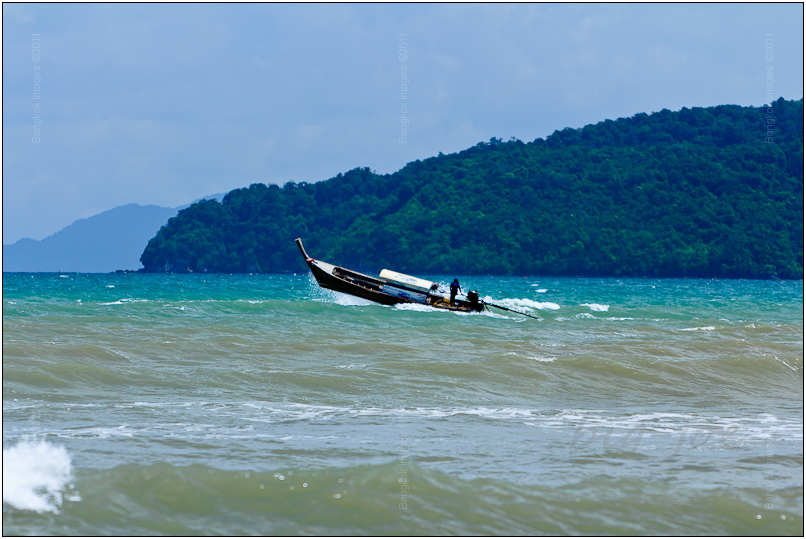
Canon EOS Rebel T2i 550D, EF 70-200 F/2.8L IS USM @ f/2.8 1/250th 200mm (320mm equivalent) ISO 100
Boats are interesting subjects but I had difficulties capturing sharp images of them.
Back on the western end of Ao Nang beach I discovered an outcrop of rocks with a concrete walk on it. I used this location several times to capture a variety of images. It became a favorite spot for shooting images and watching the sun set. It’s not difficult to get to, just walk onto Ao Nang beach turn to the right so the water is to your left and follow the beach until it ends. Here you will find the rocky prominence. To the right, away from the ocean, towards the last hotel on the beach is an easy climb onto the concrete path without having to risk climbing over the jagged boulders.
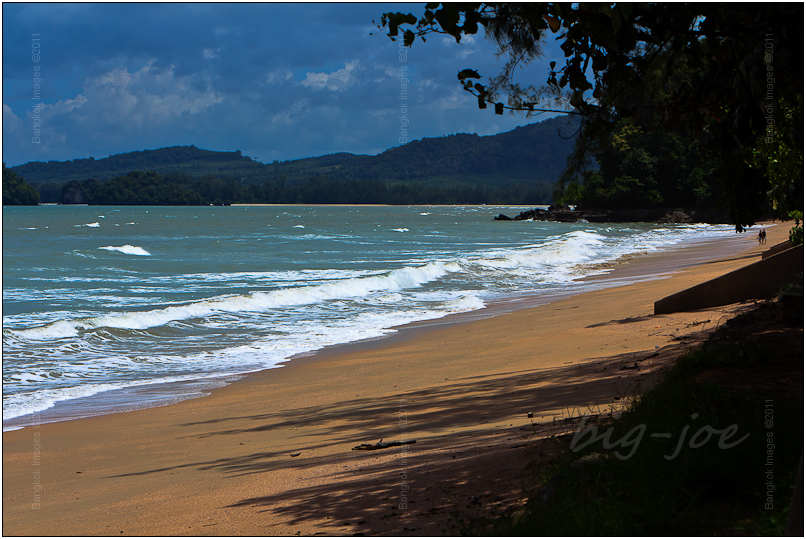
Canon EOS Rebel T2i 550D, EF 70-200 F/2.8L IS USM @ f/10 1/250th 70mm (112mm equivalent) ISO 100
In this image you can see the rocky point protruding out into the water at the end of the beach.
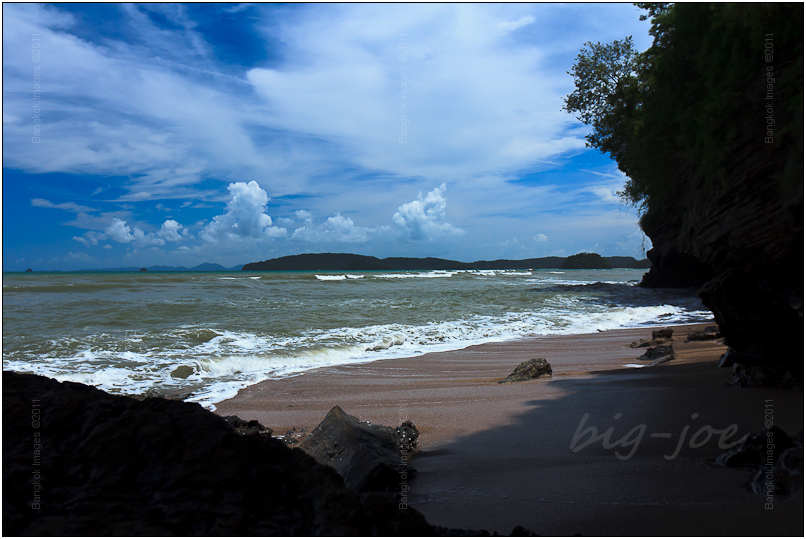
Canon EOS Rebel T2i 550D, EF 16-35 F/2.8L USM @ f/2.8 1/2000th 16mm (25.5mm equivalent) ISO 100
On the far (west) side of the rocks is a tiny beach that I found to be an interesting subject. Located in the shade of a cliff others may find it useful for other activities.
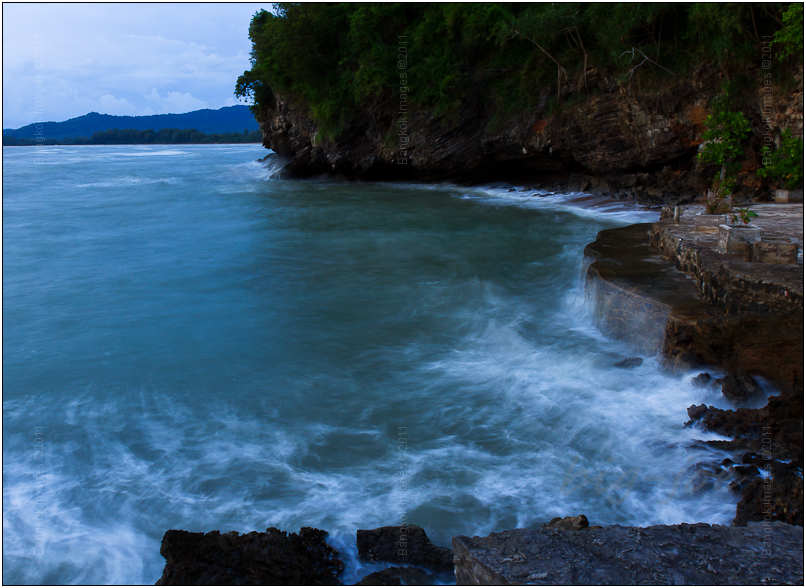
Canon EOS Rebel T2i 550D, EF 16-35 F/2.8L USM @ f/22 2.0 sec (tripod) 16mm (25.5mm equivalent) ISO 100
I continued working on long exposures of the waves from the tripod.
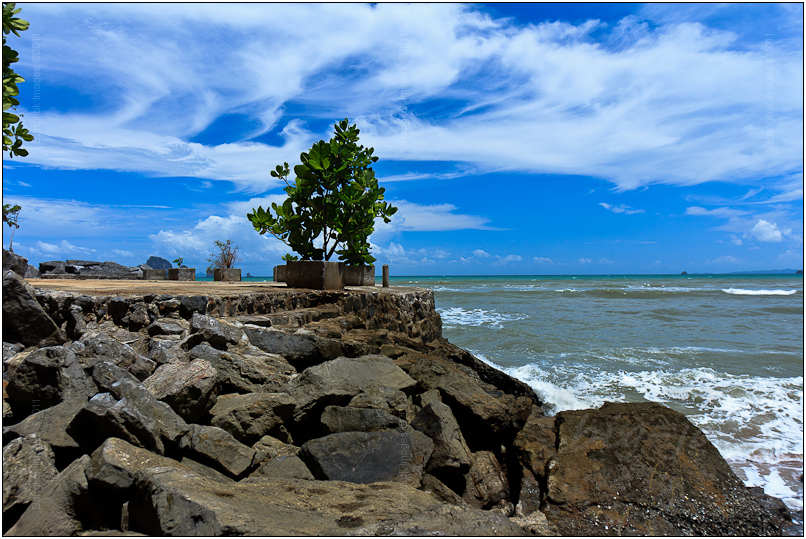
Canon EOS Rebel T2i 550D, EF 16-35 F/2.8L USM @ f/2.8 1/800th 16mm (25.5mm equivalent) ISO 100
Looking back at the rocks and concrete walk from the west side.
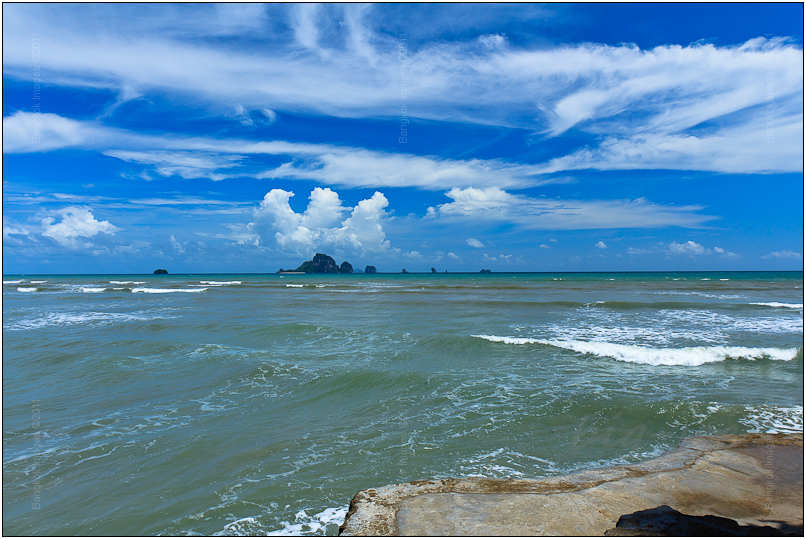
Canon EOS Rebel T2i 550D, EF 16-35 F/2.8L USM @ f/10 1/100th 16mm (25.5mm equivalent) ISO 100
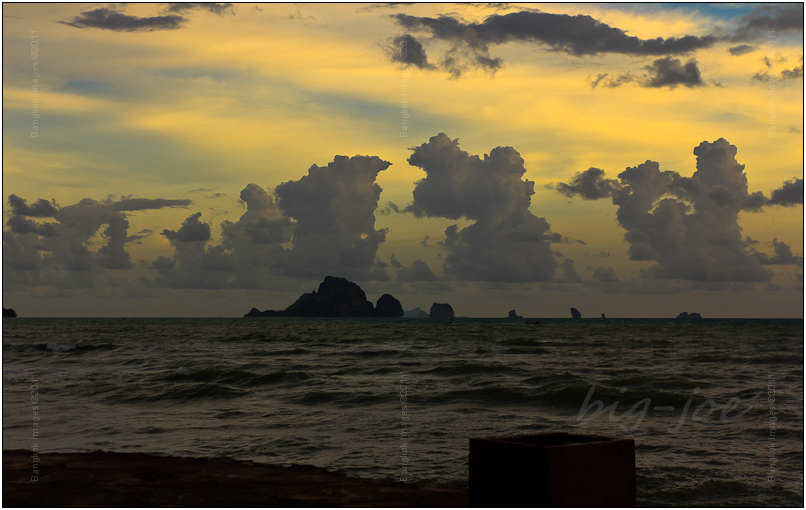
Canon EOS Rebel T2i 550D, EF 16-35 F/2.8L USM @ f/10 1/100th 16mm (25.5mm equivalent) ISO 100
These two images look to the south at the pillaring islands that add to the landscape. They were taken less than 10 meters apart at different times of the day using 35mm vs. 16mm, what a difference.

Canon EOS Rebel T2i 550D, EF 16-35 F/2.8L USM @ f/2.8 1/500th 35mm (25.5mm equivalent) ISO 100
This is one of my favorite shot of the trip. It was taken from a tripod with a remote in order to catch the splash at just the right moment. A different angle a bit to the right or left might have provided a better perspective though. This image has the near, mid and far elements crowded in line drawing attention to the bottom left corner of the image. I still like it though.
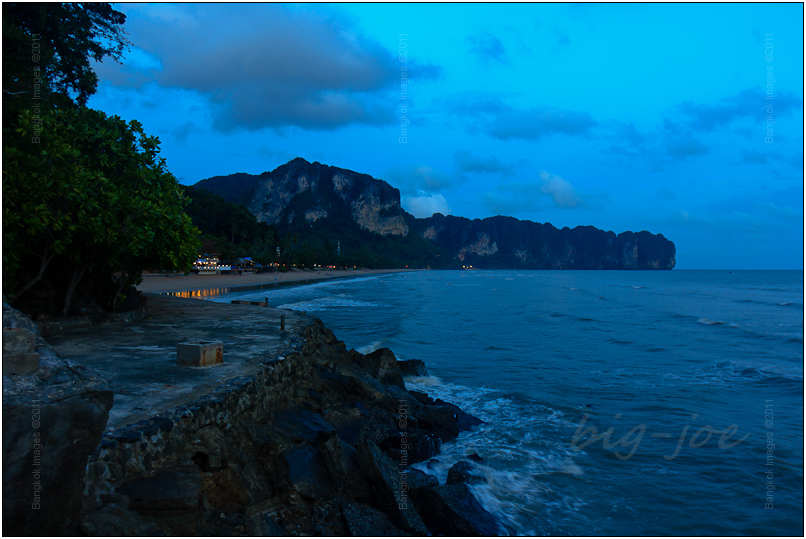
Canon EOS Rebel T2i 550D, EF 16-35 F/2.8L USM @ f/2.8 1/6 sec 16mm (25.5mm equivalent) ISO 100
You can capture Ao Nang beach at different angles and perspective from the rocks. Be careful though, the waves can sneak up on you and your equipment. I watched a lady standing near the edge, taking in the sunset, get soaked by an unexpected wave. She was in her disco clothes, ready to go out. I bet some poor guy probably had to wait another hour for her to change and get made up again.
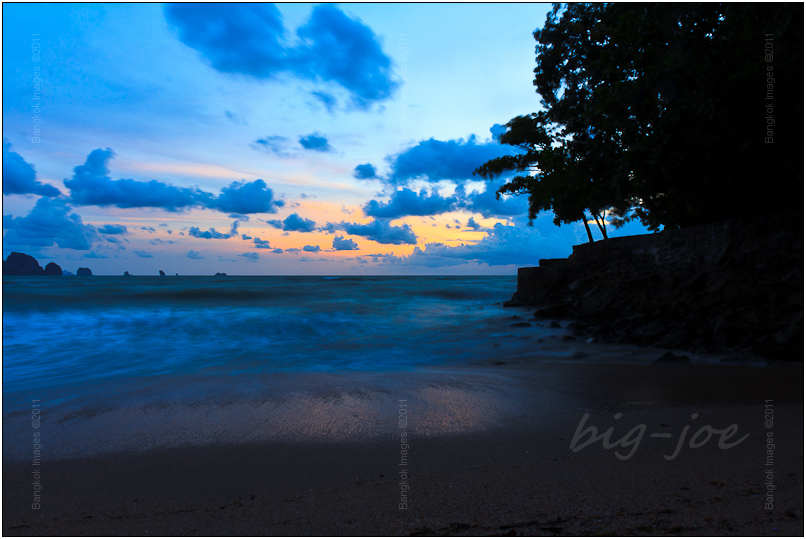
Canon EOS Rebel T2i 550D, EF 16-35 F/2.8L USM @ f/22 4.0 sec (tripod) 16mm (25.5mm equivalent) ISO 100
As I continued to work on the long exposures things started to come together. This was taken on the tripod with it set low to the ground.
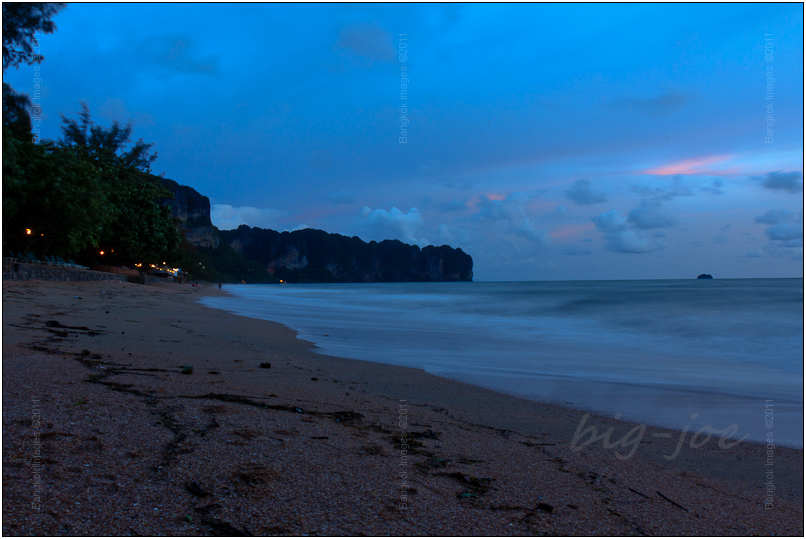
Canon EOS Rebel T2i 550D, EF 16-35 F/2.8L USM @ f/22 6.0 sec 16mm (25.5mm equivalent) ISO 100
Shot from the same position with the camera realigned down the beach this six second exposure was the longest. You can see tree branches and clouds become blurred due to the almost constant ocean winds.
I hope you enjoyed the images. I have to say that none of these images are straight out of the camera. All were edited, some heavily, in Photoshop Lightroom. I sent a few images to Steve and he was happy to post process and return them. The changes he made were incredible. These images were the closest I could get to what he produced following the sites tutorials and his advice. I will leave it to him to post his versions. I believe he was interested in doing a tutorial on it so maybe we will see them in the future. Seeing what editing can do for an image I’m excited about getting into one of Steve’s workshops and learn more.
This was one of my most enjoyable trips to the Kingdom where the laid back atmosphere of Krabi provided just the right mix of what I wanted. The Thais were awesome and didn’t seem negatively influenced by the tourism industry. The samlor drivers were plentiful and not pesky. Many of the bar owners and their staff were enthusiastic to have customers. There was a variety of venues from pubs and lounges to music bars featuring hip-hop, reggae and live rock. The restaurants were a bit low in stock on a few things, like lamb, this most likely due to it being the low season. The Thai food street vendors were plentiful and offered a variety that included some Thai Muslim dishes I hadn’t tried before. There were a few tailor shops but not many and it was easy to avoid the touts. The hotel staff was always busy and eager to provide for an enjoyable stay. I enjoyed a daily ritual of a swim and margarita at the pool bar, didn’t get a single massage for some reason, drank my fill of Starbucks and photographed as much as I wanted but discovered that I had only scratched the surface of Krabi.
The Rains did come, mostly short in duration and late at night. With the rain came the clouds. Without the clouds and their prismatic way of reflecting light my images would not have been as enjoyable. It was a great vacation where I was able to capture some good shots with very little effort. I look forward to returning during the monsoon for another Krabi show of light.
Day Trading PC Build *menu
Introduction
Recently Bangkok Images has started a computer building service which I hope will serve the expatriate community when the local stores come up a bit short. I’ve written an informational page here.
In the past I’ve brought you two other builds, both high-end imaging workstations, one in a mid-tower case and another in a smaller compact case. Both were popular pieces, but the compact build appealed to many. So many in fact, that a well known high end custom builder started carrying this same model component for component. You know what they say about imitation and flattery.
My computer builds aren’t merely a bunch of high end components bolted together. Instead, each ‘build type’ is given a great deal of thought and a significant amount of research, and a “design” using available parts is decided upon. Priorities are given first to function, then to reliability, and finally to the best aesthetics possible for a modern office. My builds are designed for a 100% duty cycle, in that they can operate 24/7 and at full load if necessary. Efficiency is important, but we want the PC to be as quiet as possible. Finally it should be easy to clean so filters are located at all air intakes to encourage regular maintenance.
I’m not exaggerating when I say these systems are second to none. There are no “standard” systems, each system is built to your unique requirements and budget. If I feel you’ll be better served by a pre-built in a local shop I’ll tell you. And I often do, I won’t build a system for a client when our priorities aren’t matched.
A PC For Day Trading
So it was interesting to be contacted to build a day trading machine. A day trading machine doesn’t need the power of an imaging workstation, but it has its own unique requirements in that it needs to support 8 or more monitors. All the other priorities apply, and in this case the client wanted the power as well. So I’m going to briefly outline my reasoning for each component of this build as we go through it piece by piece. In coming articles I’ll be individually reviewing the more interesting components and in this build there are many of those.
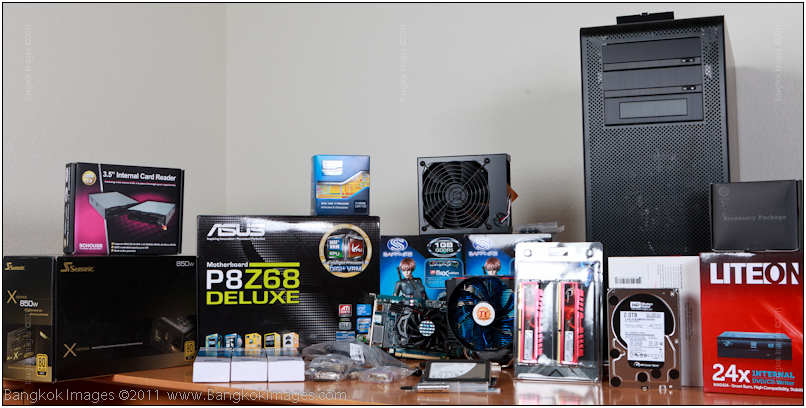
The Case
An attractive case is important, but a case does more than hold your components and look pretty. A good case must have proper thermal flow for adequate cooling which is especially important in Thailand. More, its acoustic signature should be very low so it’s not distracting while your work. A quality case should also be easy to clean, so filters are required at the major air intakes. And it goes without saying it should be well built, as light as possible for easy movement, and have easy access for the eventual replacement of components.
There are $25 cases, and there are $1000 cases. Most often the $1000 cases are unique niche products not really useful for our applications. But $25 cases have many sharp edges, low quality loud fans, fit and finish is poor, and they can generate a lot of noise. What we want is a case where a proper amount of engineering went into the design to meet the above requirements, and quality components to meet the engineering requirements. A case like this generally costs from $150-$300, maybe a bit more on the very high end.
When searching for such a caseLian-li is always high on my list to check first. They’ve made a name as the Rolls Royce of computer cases and for good reason. Checking their catalog I noticed a recent model, the PC-V1020 which comes in three popular colors, black, red, and silver.

The PC-V1020 is an all aluminum case with attractive anodizing. This particular case has a pull out motherboard tray for easy access, USB 3.0 support on its top panel ports, and attractive matching optical drive bay access doors. It has large 140mm fans on the front which ride on liquid bearings generating almost zero noise, and two 120mm fans on the top and back to exhaust the heated air. It comes standard with insulated metal wheels and it can hold up to 8 3.5 inch drives, more if you get creative. I won’t say more about this case until the review, but it is the perfect case for this build. One of Lian-li’s best products yet.
As a bonus Lian-li makes an optional graphic card duct and fan to keep the video cards cool, and since we’d be running multiple graphics cards this option is highly desirable.
Motherboard
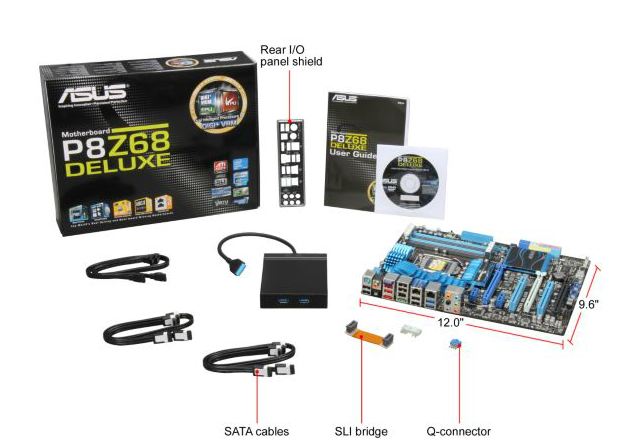
This client requested the newest x68 motherboard to support Intel’s latest new Sandy Bridge processor. He also specified dual LAN ports because it’s common with day trading machines to have a backup internet service in the event one has service issues. It turns out the dual LAN ports which used to be very common on previous generations of motherboards are now relatively rare on the x68 series, but we still found a top quality Asus P8Z68 Deluxe ATX sized motherboard.
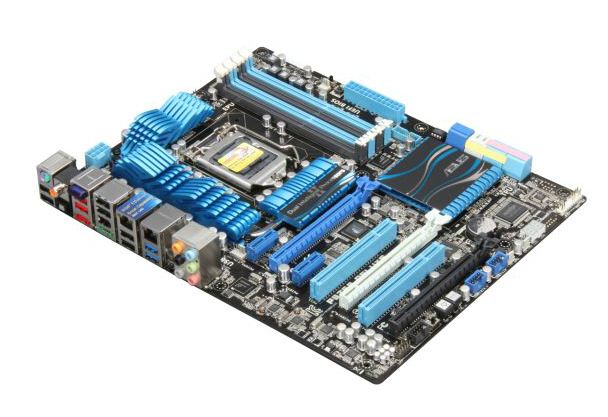
This series of motherboards is built to very high standards to support gamers, features an imaging or day trading machine will benefit from even if we won’t be over clocking or gaming. Thicker foil runs, 24 phase power regulation with high quality Japanese capacitors, a plethora of USB 2.0 and USB 3.0 ports, and much more. This is a high quality full featured motherboard with all the newest technology. A perfect choice.
CPU
Intels new Sandy Bridge desktop processors are very capable and they run cooler because they only generate 95 watts vs. the last generation which generated 135 watts. Core for core, there isn’t a more powerful CPU made for the PC market.
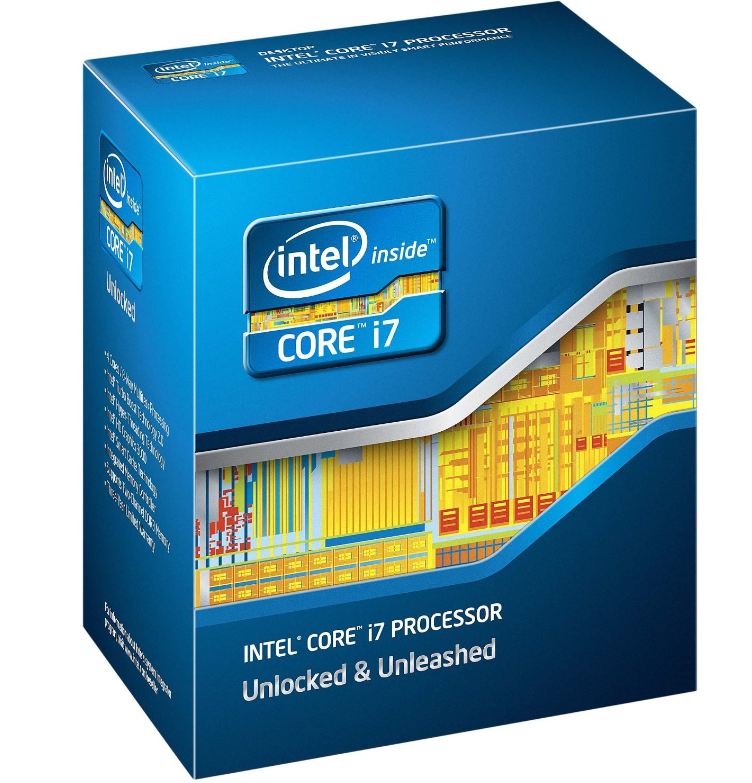
Random Access Memory (RAM)
There are 100’s of choices when it comes to RAM making it a daunting task to find the right RAM. Each motherboard will have a listing of “tested and certified” RAM recommended. From
this list you can then look for the fastest and best quality RAM. In our case the Asus P8X68 Deluxe natively supports RAM with speeds up to 2133, this means by selecting “Profile 1” in the
BIOS the timing and clocking settings will be entered for you and you can be assured your RAM will work at these speeds without issue.
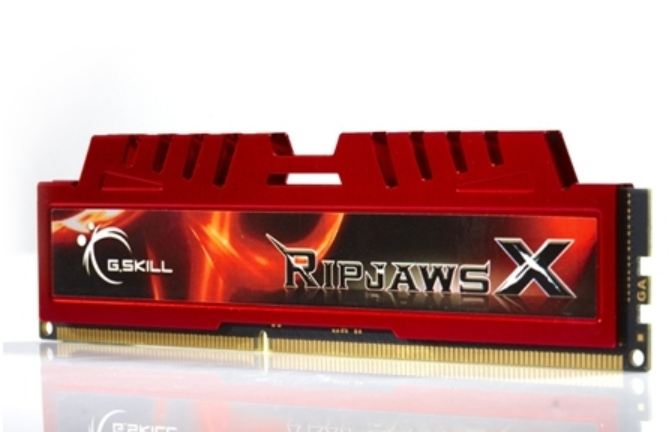
Gskill makes some of the best and most reliable RAM available. It was easy to source their Ripjaws X series from the motherboard list of certified RAM, and the motherboard was alsolisted on the Gskill website as supported. 16gb would allow this client to keep all his day trading programs in memory for the best performance at all times.
CPU Cooler

There are even more CPU cooler choices than RAM choices. Knowing which one works the best, fits in your case, and will clear your other components has been and continues to be the subject of many dedicated websites and testing mechanisms. The average
person doesn’t keep up on this level of detail, but I do. I was looking for several factors. The ability to cool, even in the tropical heat of Thailand, adjustability so the fan can be set no higher (or louder) than it needs to be, and I wanted the fans easily removable so they can be regularly cleaned and the cooling efficiency maintained.

The Thermaltake FrioOck currently sits at or near the top of each such testing site, had an adjustable rheostat, and an easily removable fan assembly. It’s rated to dissipate 240 watts, and the Intel 2600k CPU only generates 95 watts. Clearly this CPU cooler will do the job, and it will do it at the lowest fan sittings helping make the system as quiet as possible.
Power Supply
I can’t stress enough how important a quality power supply is, and I don’t want to make you listen to the boring details while explaining why. One way for an average consumer to tell about the quality and efficiency of a power supply is to check outthe 80 Plus website here. This is an independent testing organization in the mold of the Underwriters Laboratory. Any power supply earning their rating is probably “good”, but any power supply earning their gold and platinum ratings are almost always excellent.
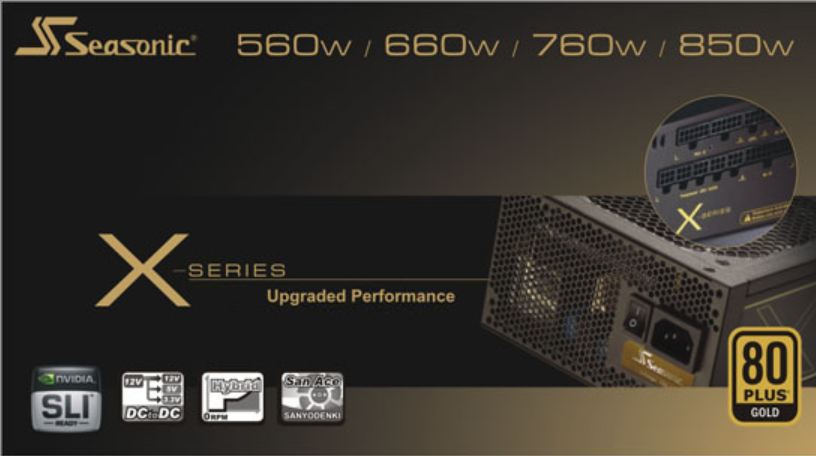
At the time I sourced this computer SeasonicUSA’s X-series earned an 80 plus Gold rating and was easily one of the better power supplies on the market. Since, they’ve come out (this week in fact) with an 80 plus Platinum lineup I’ll check out soon. Because this client would be running multiple video cards to support his 8-12 monitors, 16gb of RAM, and a high-power CPU, we wanted to be sure to have enough power. And because this particular power supply has a hybrid fan that only cuts on at greater than a 50% load, it sure would be nice to have the fan rarely cut on. We selected the Seasonic X-serires 850 watt power supply. I’ll be writing a review on this gem, it exceeded every requirement and expectation.
Video Cards
For a day trading PC the video cards are vital. You want to be able to run as many monitors from a card as possible, and support DVI and HDMI outputs which are the most common inputs on reasonably priced monitors commonly used with day trading machines. There are cards which support 6 Displayport monitors, but this client already had DVI monitors.

We searched and came up with the Sapphire FleX HD 5670 1gb GDDR5 boards which can support up to four DVI monitors each. The price was very reasonable as well. We ordered 3, and we ordered 3 HDMI to DVI cables, and 3 Displayport to DVI active adapters, all sourced from Sapphire for maximum compatibility.

System Drive
Reliability more than speed is a key requirement of a day trading PC so the choice was easy, we sourced an Intel 320 Series 160gb SSD to use as our system drive. I reviewed one of these earlier here.

This is a tested solid choice which runs about in the middle of the pack when it comes to speed, but is at the head of the pack when it comes to reliability. For our purposes I don’t know of a better choice.

Data Drive
A day traders data storage requirements are not anywhere near as large as a photographers would be, but the reliability of that data is just as important. When it comes to a high quality data drive one stands head and shoulders above the crowd and that is the Western Digital Caviar Black. We chose a 2tb model for this build. To be clear, we put our operating system and programs on our system drive, and our data, music, and videos on our data drive.
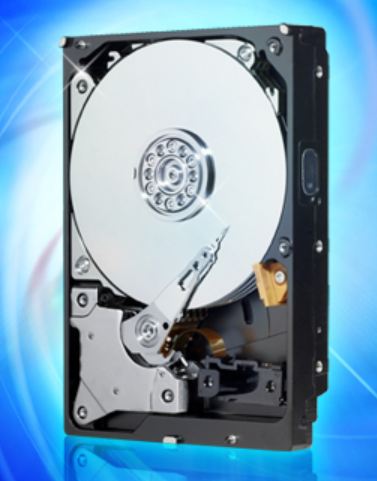
Misc Drives
For an optical we selected a basic LITEON DVD/DVDRW iHAS424-98 with Lightscribe support.
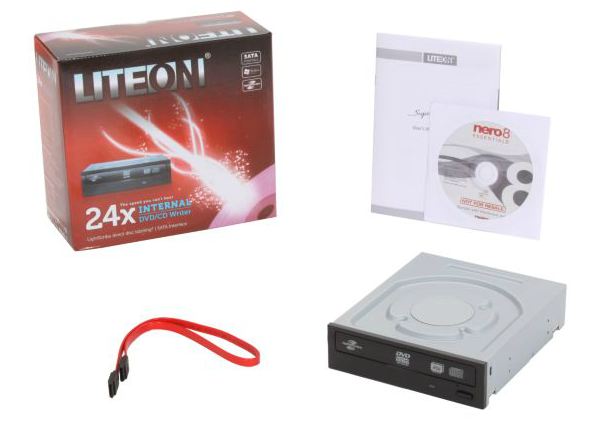
And for a flash memory reader a USB 3.0 supported Koutech IO-RCM630 3.5 inch front panel device.
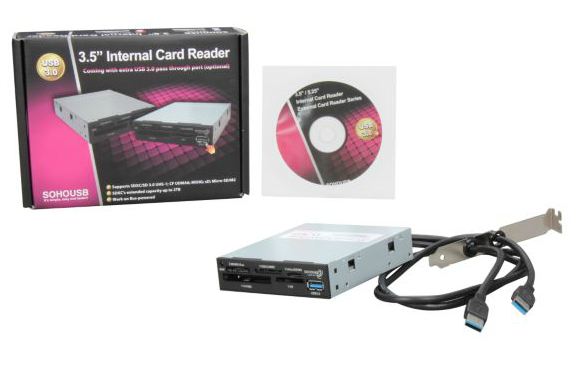
The Build
The build was easy because of the Lian-li PC-V1020b’s pull out motherboard tray.

Here we mount Intel CPU 2600k on the the Asus P8Z68 Deluxe motherboard making sure we’re wearing an anti-stat strap. Anti-stat straps are critical to ensure trouble/glitch free systems.

Then we mount the motherboard on the pull out tray making sure to snug down the mounting screws, but not to cause damage by over tightening.

Mounting the RAM modules can be a bit tricky.

They need to be carefully aligned with the aligning pins and then pressed down hard until the retainers click firmly. Many are afraid to press this hard, but if your motherboard is properly mounted the RAM modules will click right in as they should.

Next we’ll mount the Thermaltake FrioOck CPU cooler using the manufacturers directions for the mount and thermal paste application. It’s critical this is done right to ensure good cooling, and that the fans blow air across the heatsink and out the back plane exhaust fan.

Looking down on the CPU cooler you can see how close it is to the RAM modules and other components. Proper selection is vital.

Now the three video cards can be mounted and this finishes up the back plane

Next we’ll mount the case face plate to the power supply making sure the power supply is orientated so the fan is facing down where it can draw air in through the case cutout and filter.

We’ll slide the power supply into the chassis and secure it with the four thumbscrews.
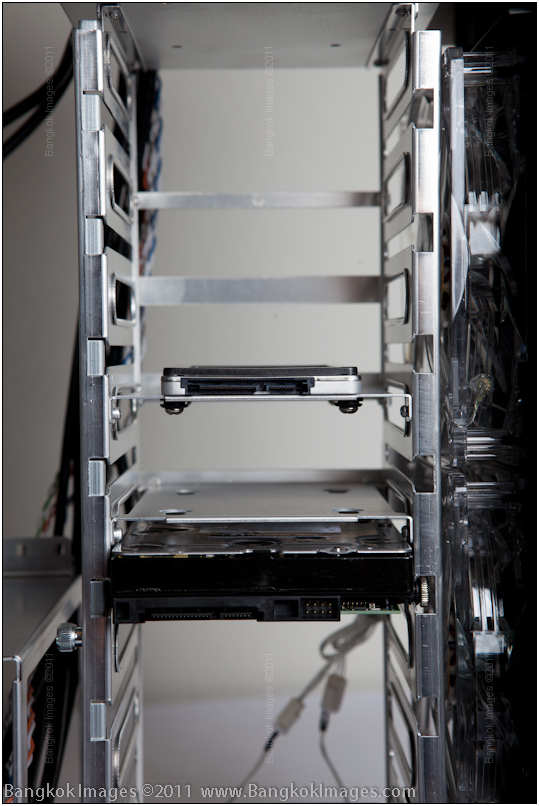
The SSD and WD Caviar Black 2tb hard drive are now mounted in the drive bays.
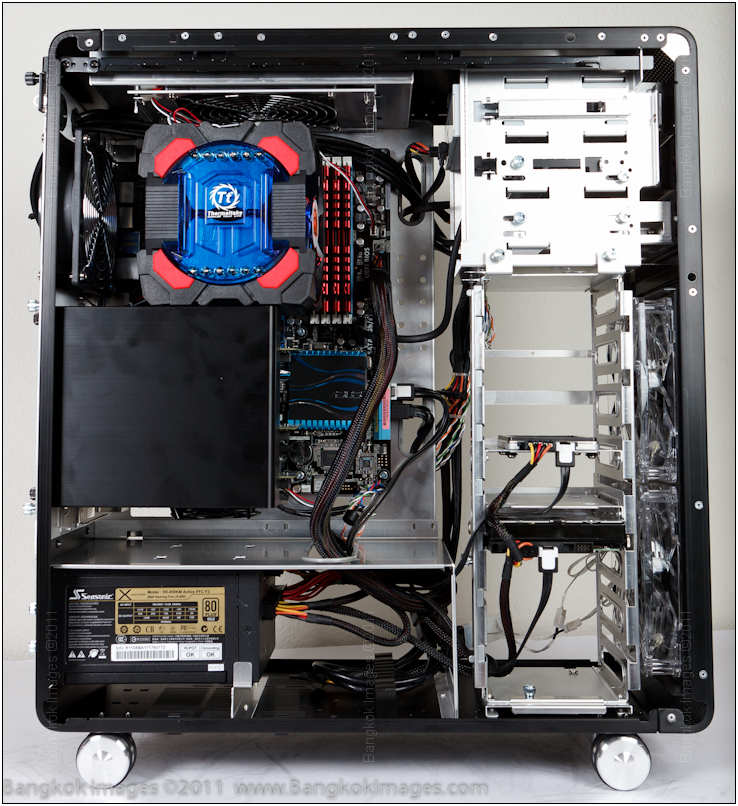
Here we have the backplane slide in and secured and the cables for the power supply and SATA connectors ran. I can’t stress how important it is to properly mount and run the cables so they don’t interfere with air flow. It doesn’t take much to knock out 40-50% of your airflow with cabling, so when possible run your cables behind the motherboard and bring them through a cutout right where they’re needed.
If this is done right the case should look very clean and neat. Also note the black square device over the video cards? I didn’t show this earlier, but this is the Lian-li optional BS-06 duct and fan to vent the hot air away from the video cards.

Basically this is it. The machine is built. The optical drive and flash memory 3.5 inch adapter are in the upper area where you can see them from the front. The Asus P8Z68 Deluxe motherboard also comes with a 3.5 inch USB 3.0 dual port adapter which you can see right above the flash memory reader.
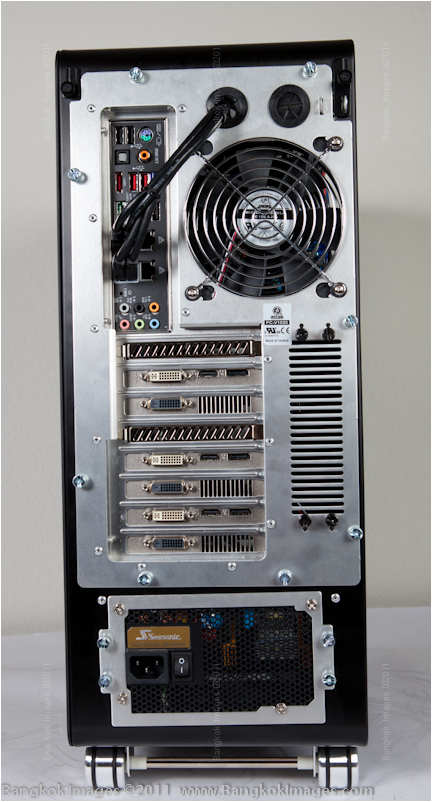
The back view shows the rear of the video cards, the rear of the power supply, the back connectors, the rear exhaust fan, and those four black thumbscrews at the middle right hold on the optional video exhaust duct/fan.
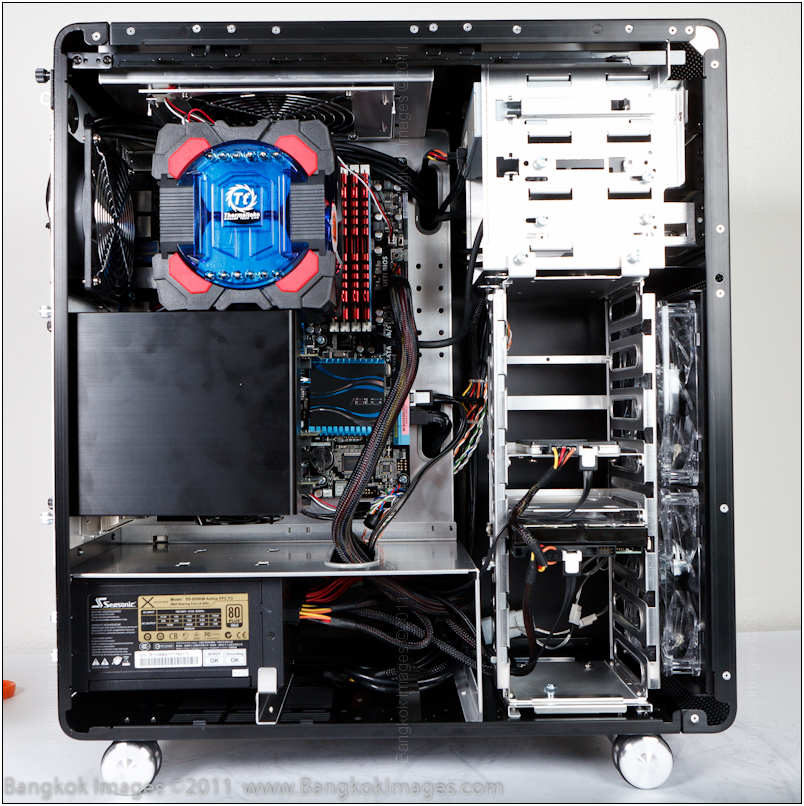
This is the completed PC with only the side cover left to attach. I’m pleased with the cable routing, the tight but perfect fit of the CPU cooler, the airflow, and it’s nice that there’s room for 7 more 3.5 inch hard drives and 5 more 2.5” drives.
Performance
Unfortunately I don’t have 8 monitors laying around to test this system fully, but I did manage to connect four monitors. After installing Windows 7 x64 Ultimate SP1, all the updates, updated the motherboard BIOS, 2 chipset firmwares, and all the drivers, I gave it one more close look before plugging it into an adequately sized APC UPS device and powering it up.
Immediately and silently the new Day Trading PC came to life and booted into the new UEFI BIOS which is a new style of BIOS which allows your mouse to navigate the menus. It also natively supports hard disks larger than 2.2tb. There are other accessibility related enhancements mostly useful for those who overclock.
With ambient temperatures of 28c the CPU cores at idle varied rom 28-31c. Using Prime95 which puts all four cores at 100% load for as long as I want, after two hours the CPU never went above 50c. Mostly it was 48-50c. The GPU’s stayed right at 42-45c. For grins I removed the optional duct/fan and the temps shot up to over 70c almost immediately. I’m glad we added this option.
In all my testing I never noticed the power supply fan cut on. With the sides on you can’t hear the two CPU cooler fans, the (2) front 140mm fans at full speed are silent, and the two 120mm exhaust fans don’t make enough noise to be heard from a meter way. What does make noise is the (3) GPU fans from the (3) video cards. This is to be expected, video cards almost always come with low quality fans. It would be possible to add an Arctic Cooler brand fan to 2 of the 3 video cards, but there isn’t enough room to do all three. Mostly though it’s a silent machine. If on the floor you can’t hear it at all. If on an actual desktop you’ll hear it a bit, but if you sat it on a rubber pad most of that would go away.
Now that we had everything sorted, updated, and 4 monitors connected, I ran benchmarks. I’m not going to post them here, it’s well known that the Intel 2600k is the fastest 4 core processor available. If we were making the ultimate video editing PC we’d use another CPU, but for most users out there the 2600K is the best CPU available. Until 3 days ago when the 2700K hit the shelves with a slightly faster clock. Ivy Bridge is expected out towards the middle of next year and that will be the next major step for CPU’s.
Yes, the CPU and RAM is overkill for a day trading PC, but many guys who day trade also game, they own cameras and process images, and in a quality machine you’re just not going to save much with a lesser CPU in the grander scheme of things.
After burning it in at 100% load for 72 hours I packed it for shipping to Thailand. Damage during shipping occurs when heavier components like the video cards, CPU cooler, drives, power supply, and so forth are allowed to move around. To protect the system I pack high-density foam in every crack and crevice, photographed the innards, put a red dot on every piece of material which needs to be removed, and then put the sides on and double boxed the entire thing.
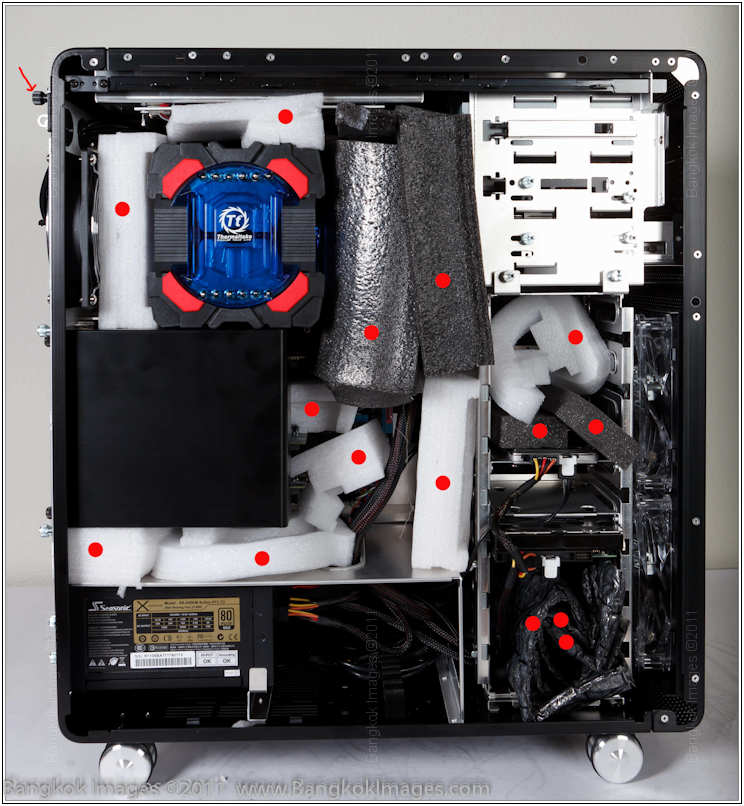
Summary
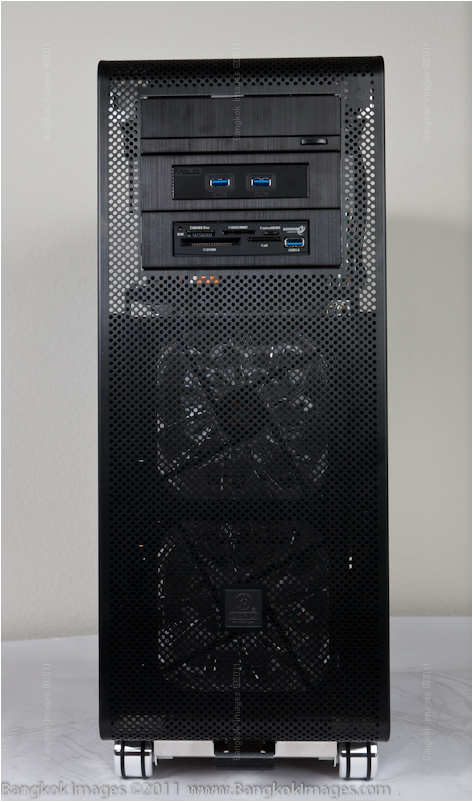
This is a great PC and not just for day trading. The case is very attractive, the system is mostly silent, and it can run 24/7 at 100% load without breaking a sweat. I’m confident it’s put together to a higher standard than you’re likely to find anywhere. Why? Because I take the time to design it right, and to put it together right. Then I test the heck out of it. Other custom builders I’m sure can do as well, but in my experience most don’t take the time to understand the customers needs and they’re paying someone in the backroom minimum wage to put it together. It just doesn’t get the higher level of attention from design to assembly to testing.
I’m always a bit sad to ship them out. Each machine represents the very latest in design and available parts, so each one is special. A machine made just two weeks later will take advantage of any advancements and new parts availability. With this one, if I built it two weeks later it would have the Intel 2700k CPU, the X-series Platinum, and the newer P8Z68 Deluxe V3 motherboard. Would any of these make a difference? Yes, but only an incremental difference and that’s the nature of the PC market. DAILY new and improved items are coming on the market. We live in great times!
If you’re interested in having a custom PC built, I encourage you to read the primer on my website and then contact me if I can be of service.
Photography News of Interest *menu
Fashion Industry Full of Predators, Especially behind the lens, Models Say. A very good read, especially if you’re considering allowing your children to model.

I love these Northern Lights snapshots.

Throwable Ball Camera May Revolutionalize Sports. Stick sent this one in and it’s a very intriguing article. After you read the article, consider our intelligence agencies have been using this and similar items for years now.

Kayaker enjoyes amazingly close encounter with humpback whales. I’d love to be this guy in the kayak IF I had my camera. It doesn’t look like he was prepared.

A few hours ago Canon announced their new "EOS-1D X" which is positioned to replace both the Canon EOS-1DIV and the Canon EOS-1DSIII. Are you scratching your head on this one too? Chuck Westfal, Canon's technical advisor explains the new EOS-1DX will feature a new 18mb full frame sensor with a 12fps frame rate, an improved metering and auto focus system, ISO range up to an extended 204,800, and a claimed best in class image quality and noise levels. There will be incremental improvements to the familiar 1D series bodies as well. This all sounds great, but will this really replace both the 1DIV and 1DSIII? Read below the two EOS-1DX images for my take on this.
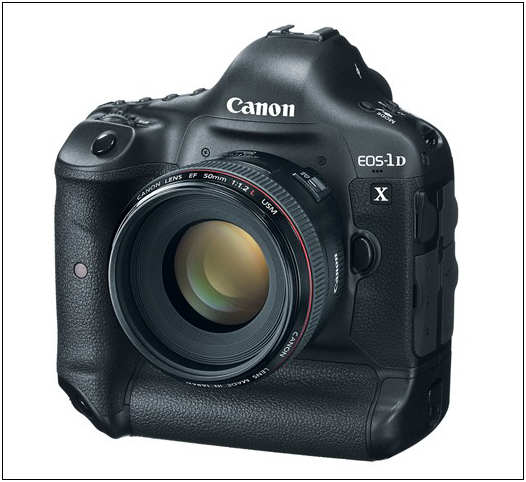
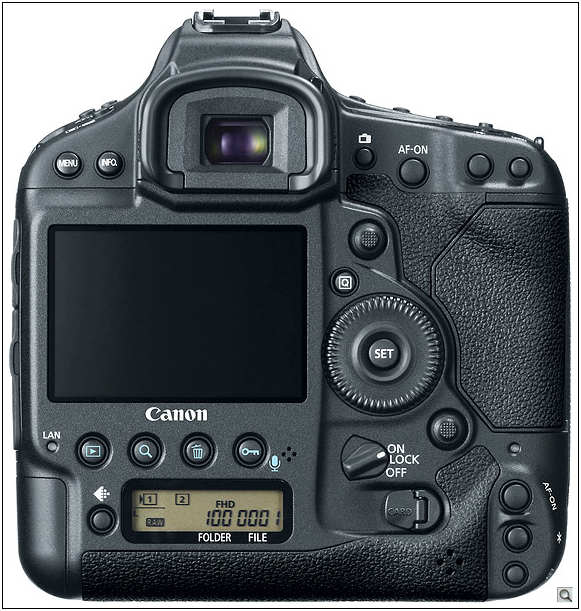
Readers Submissions *menu
Steve:
I am happy with the results of the attached before and after pictures using the Sony and LR3 for post processing. The focus is good and the colors are much to my liking.
Rick


Rick –
I wasn’t going to run these two images because they were quite simple, but as I was writing the Feature Photograph I thought how germane these two images were to your own progress and reaching for new levels. Your discipline impresses me, and hopefully will be inspirational to others.
In case you’ve missed Rick’s submissions and questions allow me to summarize Rick’s recent photography: Rick defines a certain area he wants to improve, and then he sticks with it until he does. He examines all angles, asks great questions, accepts hard critiques, all the while keeping his goal within sight. Once he feels comfortable he’s reached a certain level of competency he moves on to the next level. The next level is where we to we all aspire.
Good on you Rick!
I’d like to mention that everyone, myself included, is really enjoying the current trend of readers submissions. Everyone loves them, but remember we can really use more. I have only another week’s worth in my queue, so please take the time to put together a few images and words if you can and send them in. Thank you. info@BangkokImages.com
Readers Questions *menu
Steve:
Attached find a few shots and the settings used. What do you see, do they show clear to you, etc. Are these pictures as clear and sharp as I could expect? There are a few variations to the "A" setting used on the camera and they are so marked on the grid.
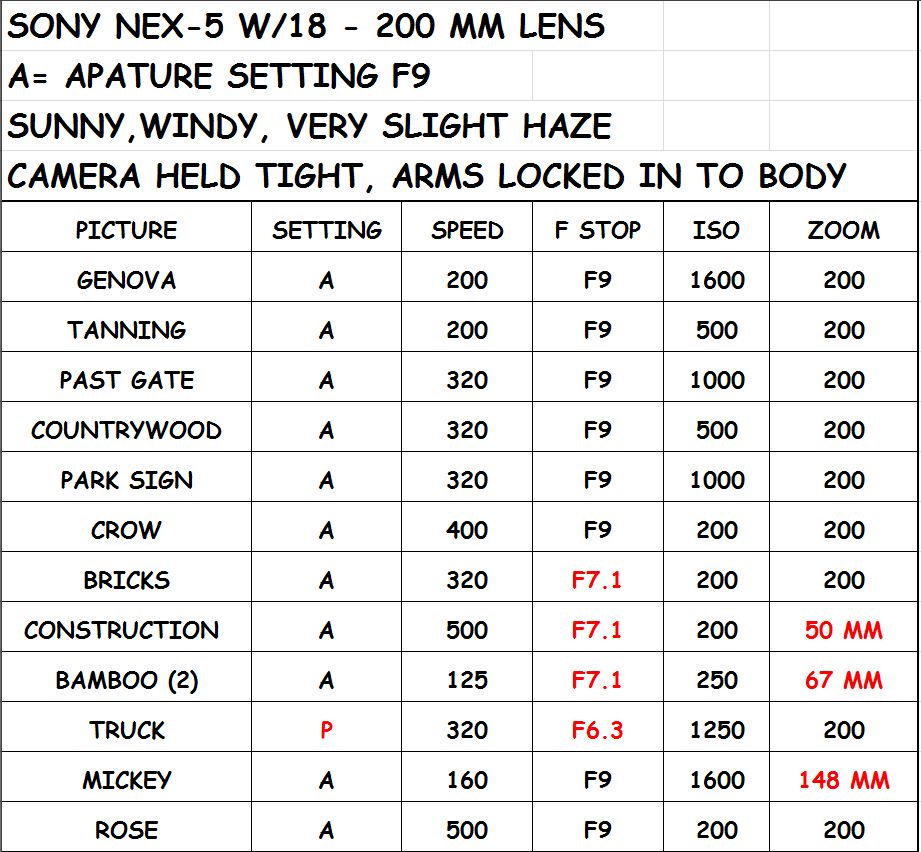
Thanks
Rickster
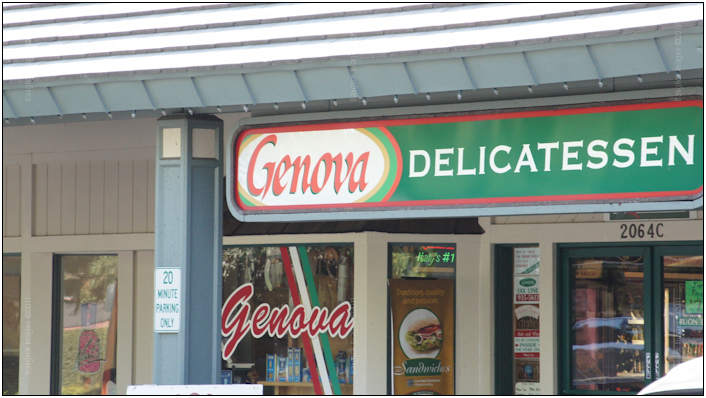
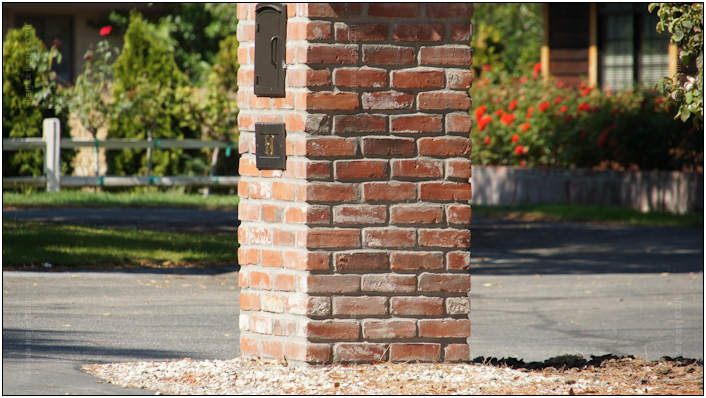
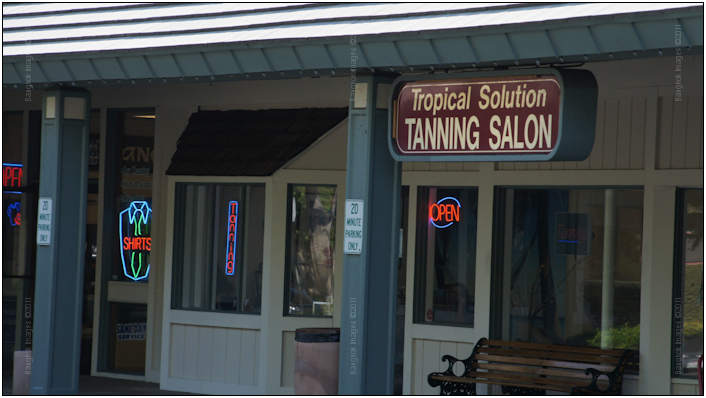
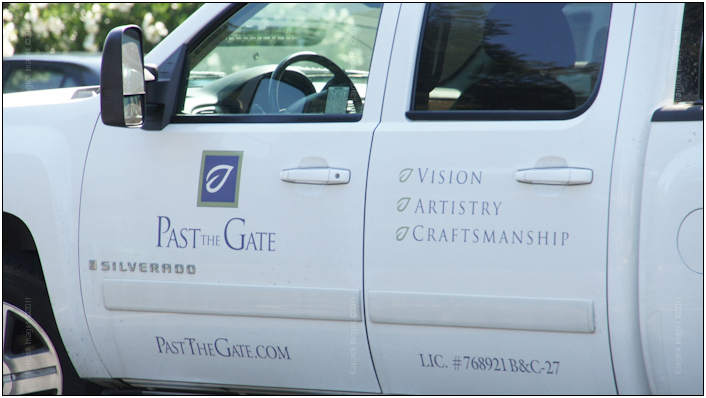
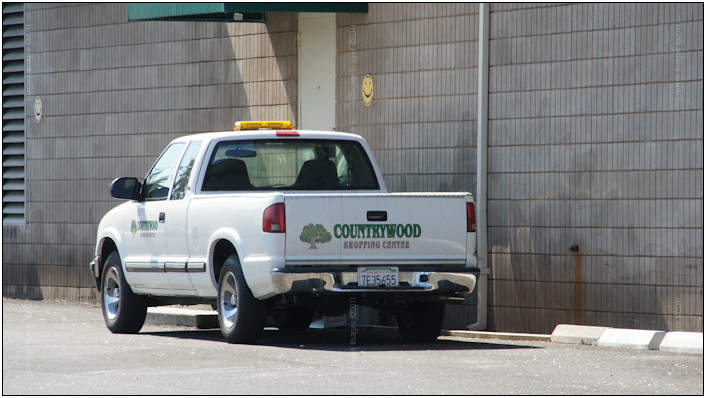
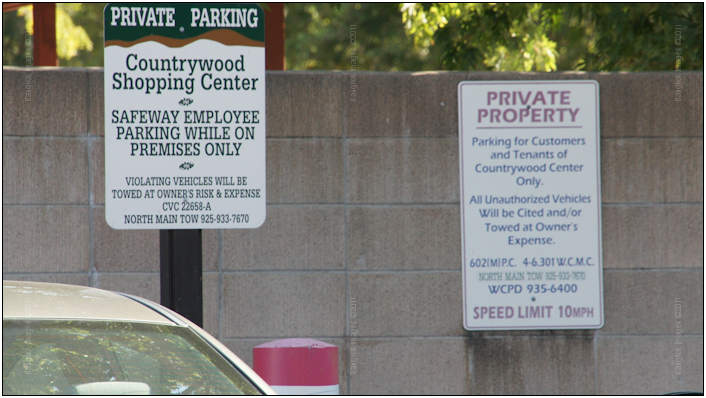
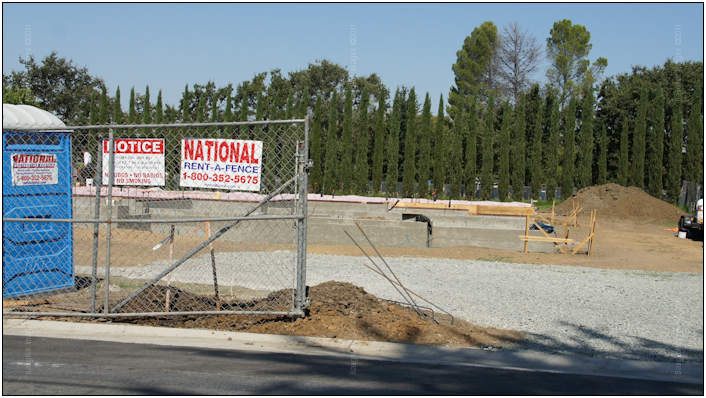
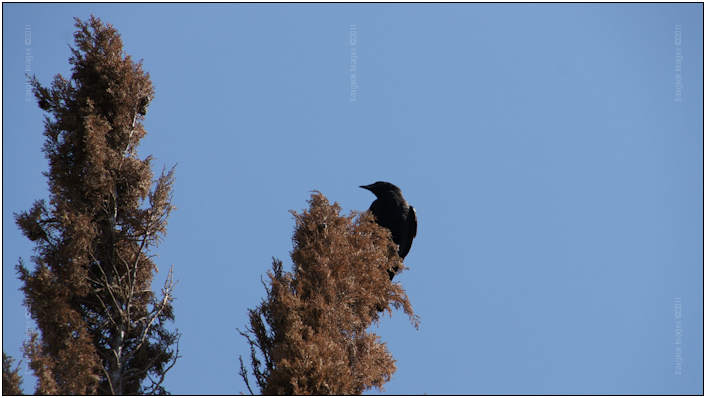
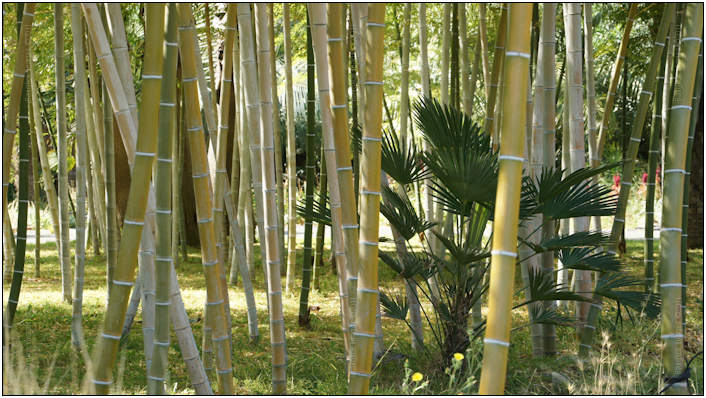
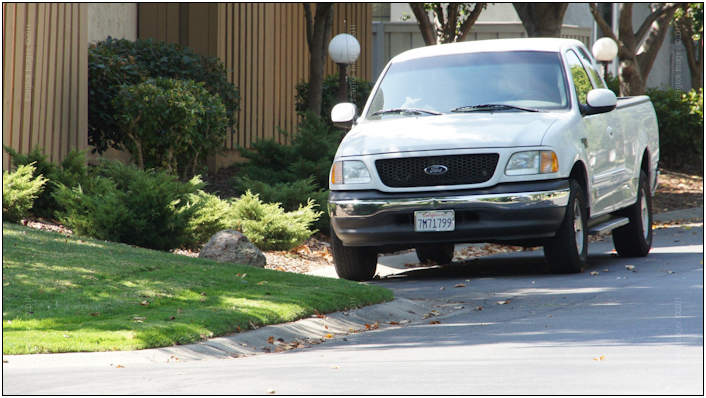
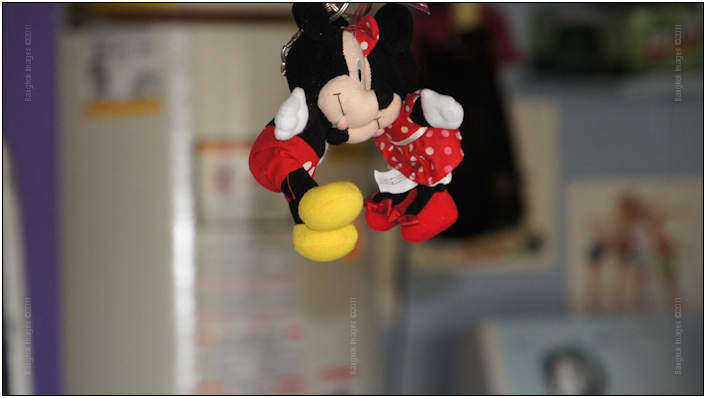
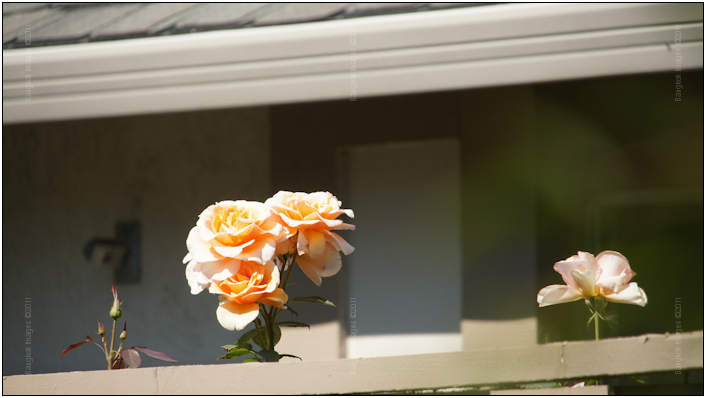
Hi Rick –
I totally missed your spreadsheet.. never had anyone do that before.. 🙂
Are you outputting these via Lightroom? It looks like you have "minimize exfil data" checked in the export dialog box.
Usually, when you send a picture in for discussion/evaluation.. you leave the exfil intact, photographers know where to look.. 🙂
Looking at the spreadsheet data.. I'm disappointed with the focus. It's close, but it still appears there's some camera shake the more than adequate shutter speeds isn't compensating for, or you might have missed the focus..
If you try the tripod method it should tell you for sure.
Keep asking questions.. 🙂
Steve
Steve,
I’ve been looking over the pre-release stuff for the new Sony NEX-5N and NEX-7. I like the OLED EVF and the bracket shooting. Maybe you could give us your take on them in your next article. Hope you are enjoying your part of the USA.
Bryan
Hello Bryan –
I bought one of the first batch of NEX-5’s in Thailand, and then the first 16mm.. and I enjoyed it a lot until I received my Fuji x100 and was reminded of what I’d been missing.
What was missing was a photographers interface, optical viewfinder, exceptional lens, and low light capability.
Sony’s NEX-5n and NEX-7 have improved their interface, but it’s still what I call a point and shoot interface. Sony knows most of the buyers of this camera will just put it in Auto and forget it has other modes, but they still need to support advanced users. Before they did this poorly, the new cameras do it much better.
But the Fuji x100 provides an interface not unlike old style SLR’s which were probably the apex of user interfaces for real photographers.. especially when you consider back then all cameras were manual focus and manual exposure. If you’re the sort of person who mostly uses Auto modes you’ll love the NEX series. If you often use aperture priority or manual modes.. not so much.
EVF’s have greatly improved, and I had a chance to do a hands on with a NEX-7.. and they’ve improved even more. The x100 has an excellent EVF mode as well. I suppose you can get used to an EVF, many do, but I’ll always find an optical superior in speed (no lag) and more comfortable with its natural view. Though, I do enjoy EVF’s that basically ‘preview’ your exposure settings as you change them but before you shoot. Very handy at times. And Sony’s articulating LCD for live view allows perspectives you won’t get with a optical viewfinder (from the hip, up close where you normally can’t get your head but your hands fit, low to the ground without having to lay on it). Still, if I could choose.. I’d choose an optical viewfinder despite the benefits of both the EVF and articulating LCD.
Lenses.. Sony’s 16mm and 18-55mm.. are both good lenses. Yet, I didn’t feel they were up to the sensor in the original NEX-5, so they’ll certainly be limited in the NEX-7. But.. if you want to spend the money.. Sony will be offering Zeiss lenses in several focal lengths. I’d consider these a must have.
Low light.. This remains to be seen and will become known in the first reviews. The Fuji x100 surprised me greatly by being better in low light than my Canon 5d Mark II. DxO scores show the 5d Mark II’s sensor ‘slightly’ superior, but not by as much as you’d think a full frame sensor should be better. Meanwhile the original NEX-5 wasn’t in the same league. Soon, we’ll see how the NEX-5n/7 compares with low light..
Many people want a zoom lens, so for these people the NEX is a no-brainer over the Fuji x100. The problem is, Sony’s zooms aren’t nearly as good as the x100’s 35mm equiv prime.. Others will be convinced the need the 24mp sensor of the NEX-7, that it will allow for things the x100’s 12mp sensor can’t give them. My guess is they’d be wrong in 95% of their instances.
What it comes down to is your personal style. I really recommend borrowing or renting the NEX-7 and its closest competition.. and living with them for at least a few days. At the same time we live in great times and we have a lot of great choices.. the NEX-5n/7 are certainly two of them.
I hope this verbosity is somehow helpful..
Steve
Please submit your questions to info@BangkokImages.com All questions will be answered and most will show up in the weekly column.
A Snapshot of Bangkok Images Week in Review *menu

I shouldn’t be surprised, but I’ve noticed a distinct trend in the way of obligations since being back in the states. While living in Asia largely I don’t exist, or perhaps better put I’m too far out of the zone to bother with, or be bothered, by obligations. It’s an 8000 mile buffer zone.
And it’s just not family and friends, but also business contacts and sponsors. I’ve found myself attending manufacturers seminars where before it was infrequent at best, asked to stop by places of business and provide evaluations and estimates, and because it’s more convenient I find myself getting involved at all levels of my profession I previously put off.
I question this because I’m not necessarily getting more done, yet I do hold out hopes these efforts will lead to me getting more done in the future. A type of professional investment?
I’ve been spending a lot of time taking advantage of the wonderful fall weather and cataloging a list of desirable locations to photograph. Several months back a good friend from another country visited and I was flat out embarrassed I didn’t know the area well enough to show him a good time, and the 50 year high heat waves we were experiencing made being outside not much different from standing in a hot boiler room. If the friend came today we would have all sorts of interesting places to visit and photograph. Thailand took me several years to properly catalog and I was adding new places all the time. I suspect my local area won’t take as long.
I’ve spent a lot of time building two key pieces of business, one local and one in Thailand. As you can see from the above piece on building PC’s for clients in Thailand, I suspect this will have a small but steady volume. I enjoy building high-end PC’s and I’m delighted to have the review material. But more, it’s always great to listen to the enthusiasm clients express when experiencing their new workstation for the first time.
I’m also working on establishing my local reputation for environmental portraits and learning the unique lighting I’ll be using to a high level of competence. Last month I probably put in 100+ hours just in studying and becoming competent in the right type and use of lights. I hope to summarize these hours into several easy to understand tutorials for those interested.
This month it’s fall, next month I’ll be writing this column as Thanksgiving and the first snowstorm race for the lead. Who do you think will when?
Some Bonus Pieces up on my site over this last month but not in this monthly include:
- What Kind of Camera Should I Buy?
- Seagate Expansion 3 TB USB 3.0 Desktop External Hard Drive, Review a great piece to read with the current hard drive shortage.
- I Fixed My MacBook Pro. A great piece by BigJoe. Check it out.
Infocus Blog, The Psychology of "Reconditioned." *menu
The landscape of the electronics market has largely changed over the last decade in ways the average consumer either doesn’t realize, or doesn’t much think about. One of these areas is how “reconditioned” products
have now become as common as satellite television and broadband.
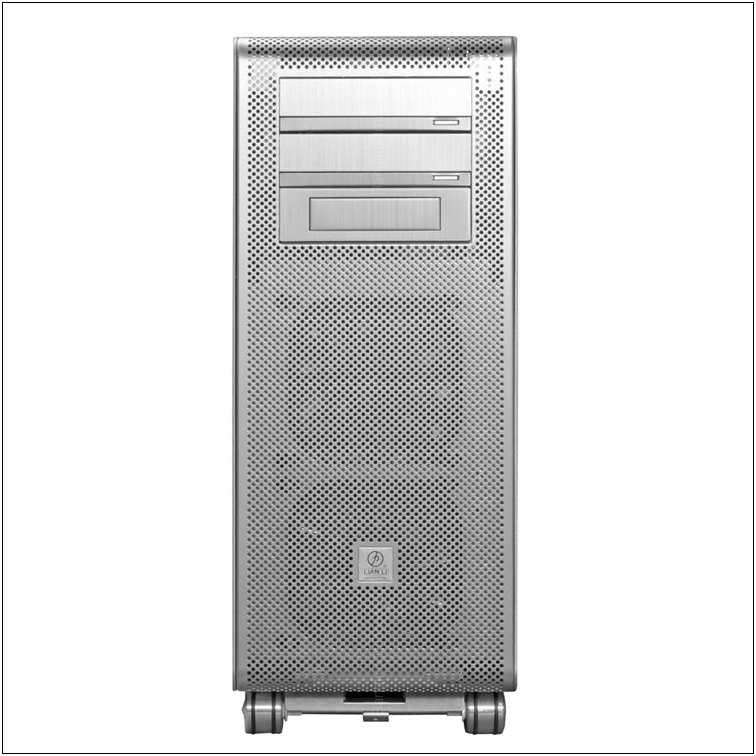
Most consumers are aware when they buy a product marked “reconditioned” that it’s either a returned product, a product ordered but not delivered, delivered but returned unused, or was damaged somewhere along the journey.
These products are carefully surveyed, brought back to new condition, diagnostics are run, and the product is usually packed in new packaging with original accessories and manuals. Reconditioned or remanufactured products ARE NOT used products.
Each manufacturer has a limit on time and usage to qualify, and it’s usually very low.
I’ve been knowingly buying reconditioned products for well over a decade from manufacturers I trust and saving a load of money in the process.
How many of you know about the Dell Factory Outlet? I’ve probably purchased
over a dozen high-end Dell laptops over the years saving sometimes more than 60-70%. Each time they’ve arrived packaged and working as new products, and carrying full new product warranties. I encourage you to check out their site.

APC who make what I consider the finest Uninterruptable Power Supplies used to have their own Outlet, but now they’ve contracted out the service to Schneider Electric who offers really great deals on reconditioned UPS devices. As an example, when
I moved back to the states from Thailand the voltages were different and I needed all new UPS devices. The 7 devices I needed would have cost me over $5500 USD’s. Through Schneider Electric I had either the same or last generation UPS devices, all 7 of them, delivered for under $1000. A huge savings. Their warranty isn’t as good as the original, but I find UPS devices trouble free for the most part so a year warranty vs. a
two year warranty was acceptable.

There are many more such outlets. I’d recommend the next time you have a major purchase, a television, computer, or just about anything electronic, that you contact the manufacturer you’re interested in and ask/search to see if they have
an outlet. They don’t make it easy to find them for obvious reasons, they’d rather most people buy their new full price products.
Liquidators often buy reconditioned products in huge quantities and market them on Ebay or Amazon or through other popular on-line retailers. The Garmin 885T GPS I reviewed here , and the Garmin 3790t GPS I reviewed here were bought for half price from such a retailer.
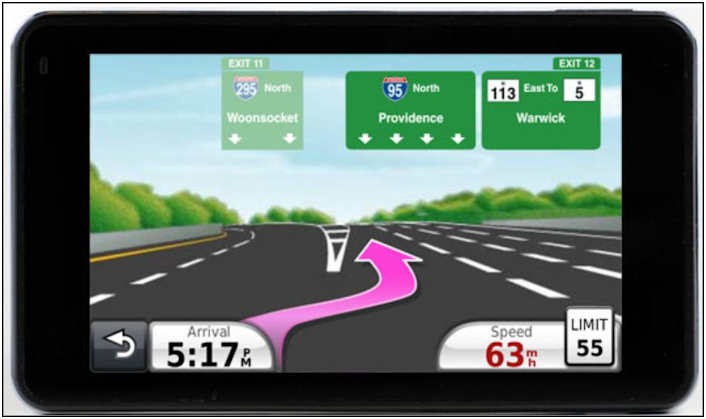
And if you haven’t knowingly purchased a reconditioned product, you probably have received one without being told through a warranty exchange. Rarely do you get a “new” item back in a warranty exchange. This is where
the best of “reconditioned” items go first, to support warranty exchanges. When there’s not enough warranty items on the shelves to meet demand, new items will be brought in, but you won’t have a choice.
A recent example was my baht 100,000 NEC LCD2690uxi2 imaging monitor. The screen started separating and NEC was kind enough to transfer my warranty to the states and send me out a new one. Well, not really new as we’ve learned. Reconditioned. Was
I worried? Was I upset? You bet, these are expensive monitors which help support my livelihood. I spend hours at times carefully color profiling these beauties and making them as accurate as possible. It makes me wince just imagining every bounce
it takes on the UPS truck getting here. So a reconditioned one? I was headed for breakdown. Until the nice lady at the other end of the phone assured me I could return any monitor I didn’t feel met or exceeded new specifications. She obviously
had a lot of experience working with distraught imaging professionals.

When my new monitor arrived it wasn’t in a new box. It was in a special shipping box designed to be reused many time and because it’s such a big and heavy beast, to make the most value from shipping charges. I unpacked my monitor, removed
the plastic, and it ‘looked’ perfect, but was it? Connecting it to my system I powered it on and entered the Spectraview II software where it could read the monitors firmware and other information as well as how
many hours were on the monitor. My return had 5333 hours. My new “reconditioned” monitor had exactly one hour. This monitor was probably taken from the box, someone with buyer’s remorse discovered it wasn’t
magic, and set it back.
But the real proof came during my profiling where I was quickly able to achieve the lowest DeltaE numbers I’ve ever seen. Was this monitor “tweaked” more during reconditioning by a human than during assembly on a
machine run assembly line? Very possibly. I don’t know, and NEC wasn’t saying.
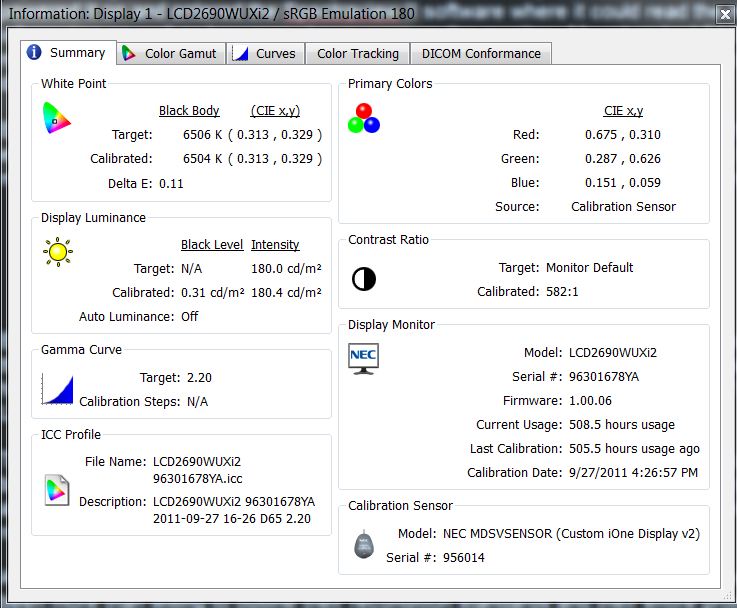
But I suspect many reconditioned electronics get aligned/tweaked/profiled/adjusted by humans, when going through the reconditioning process, where the same product going through the assembly line for the first time are handled by computers. I’m
very happy with my reconditioned monitor. In fact, I’m kinda hoping my second LCD2690uxi2 monitor developed a problem soon..
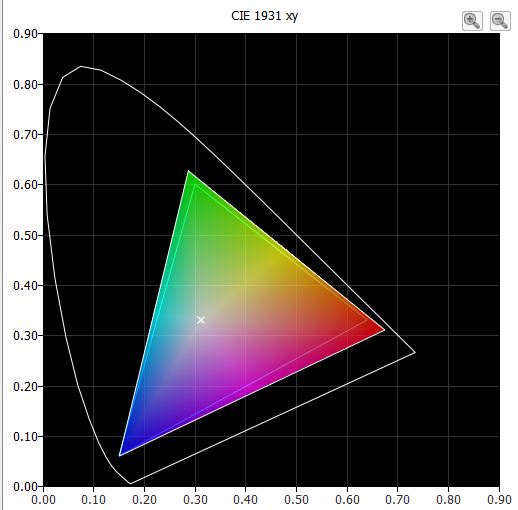
The psychology of reconditioned electronics can range from someone just not caring, to a mental devastation because their “virgin” product is being replaced with a product that has been in someone else’s hands. There
is also the feeling that the reconditioned product isn’t worth the money you paid for, that if you wanted a reconditioned product you would have paid less and got one in the first place.
All justified feelings. To a point. Understanding the process helps and each manufacturer I’ve contacted has been more than willing to outline their recondition standards and their entire process. I tend to think that companies who normally provide
a high level of custom97oil;service and/or a high quality product, put the same efforts into their recod01 itioned products.
If you can get over the “must have everything new” mindset, you can not only save yourself a lot of money, but you can sometimes end up with a more refined or better calibrated/adjusted/tweaked product. Something to consider.
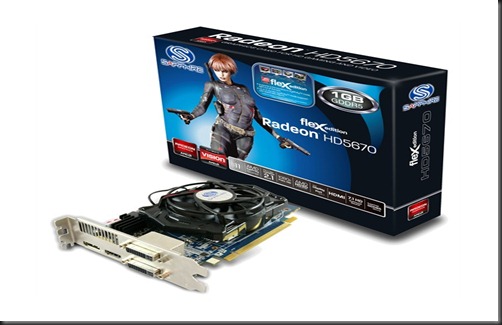
Something I’ll never consider, a reconditioned product from a company I distrust or have little respect for, for whatever reason. I try not to buy from such companies. Apple being one of them. Sure, they make great innovative products, but their
thirst for the bottom line makes me nervous, and this is beared out when examining 3 different Ipod’s, my sons Itouch, and a friend’s Iphone3. ALL had scratch marks from the tools they use to pry them open, several weren’t
seated right along the mating services, and one didn’t work right at all. And on several occasions when I finally got through to a human on the phone I was told “scratches and small blemishes are normal and to be expected.” And I said “but I paid for a brand new one, and sent you a brand new one without a blemish or scratch?” I was “handled” and told I was overreacting and it would get scratches soon anyway. Really? Try
telling that to my 14 year old Cobra sitting in the garage, still not a single ding or scratch. Some people just take care of their expensive purchases better than others. This should be recognized.

In contrast my HTC Desire Smartphone has never had a lick of trouble, but a good friends did. I was with him when we walked into a HTC
service center at MBK, and less than five minutes later was handed what appeared to be from the packaging and phone itself, a brand new unit. I asked and the pretty young lady behind the counter smiled sweetly, apologized, and told me it was “reconditioned” and would we be okay with that? Of course we would. Great service.
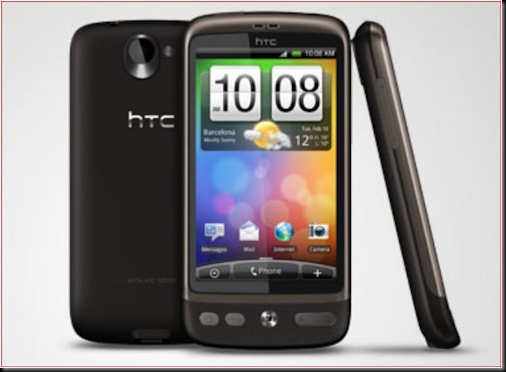
Many times it’s been said that which makes us afraid, or in this case uncomfortable, is the unknown. Not knowing what a reconditioned product really is, how old it’s allowed to be, what’s done to bring it back up to standards, and
how it affects our warranty. I hope I’ve answered most of these questions for you. Maybe something new you’ve learned reading this article is about all the great deals available from major manufacturers and I’ll caution you
once again, search hard to find their outlets. This information is rarely volunteered, even when asked. Be diligent and it will pay off.
I’m not a fan of “used” anything. I buy all my cars new, with the exception of a classic or collector car I plan to “recondition” or “restore.” I prefer to buy a new home when given the chance, but I’ll buy an older home if it’s been freshly “reconditioned” and not yet lived in. I’ll buy only new furniture unless it’s an antique I want for some odd reason, and then it won’t even come into the home until I’ve fumigated and cleaned it. My form of antique reconditioning.. J
Yet, I have absolutely no issue with initially purchasing or receiving under warranty, a reconditioned piece from a company I normally receive excellent customer service and products from. I have no issues because I understand what it is I’m getting.
I’m no longer put off or scared of the unknown. And you shouldn’t be either.
Until next time..




